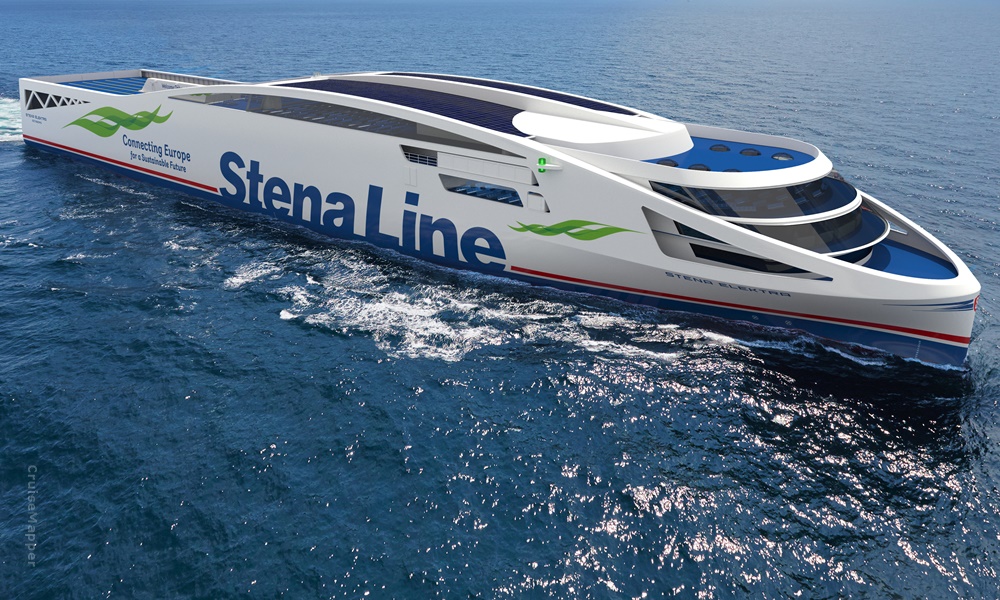Ferries
History, Review, Itineraries, Ships, Deck Plans, News
Ferries fleet

Guillaume de Normandie ferry
Routes: Portsmouth-Caen-St MaloBRITTANY FERRIESYear build 2025 / new ship Passengers 1310 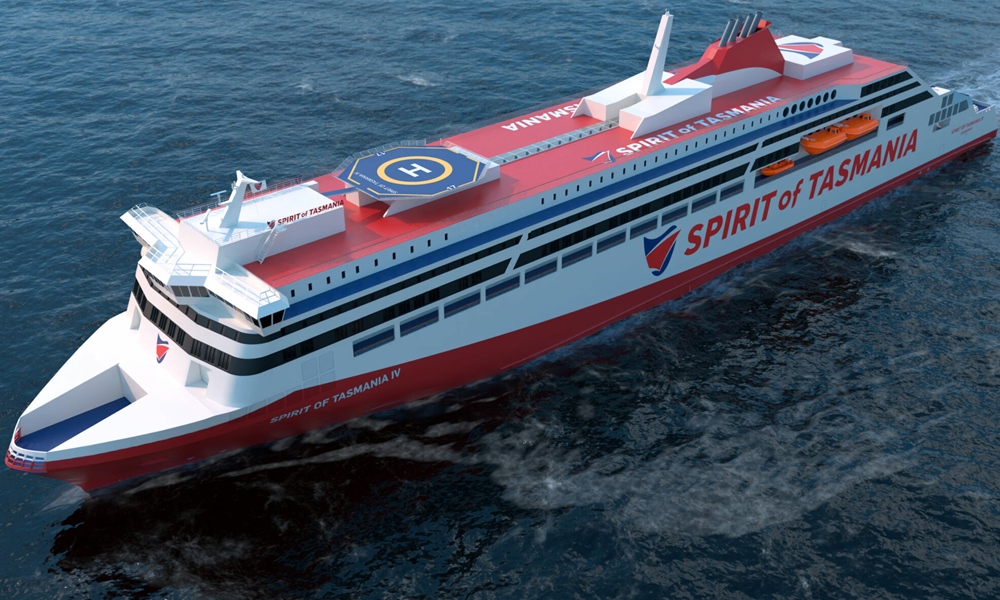
Spirit of Tasmania 5 ferry
Routes: Geelong-Devonport (Victoria-Tasmania)TT-LINE TasmaniaYear build 2025 / new ship Passengers 1800 
Saint-Malo ferry
Routes: Portsmouth-Caen-St MaloBRITTANY FERRIESYear build 2024 / Age : 1 Passengers 1310 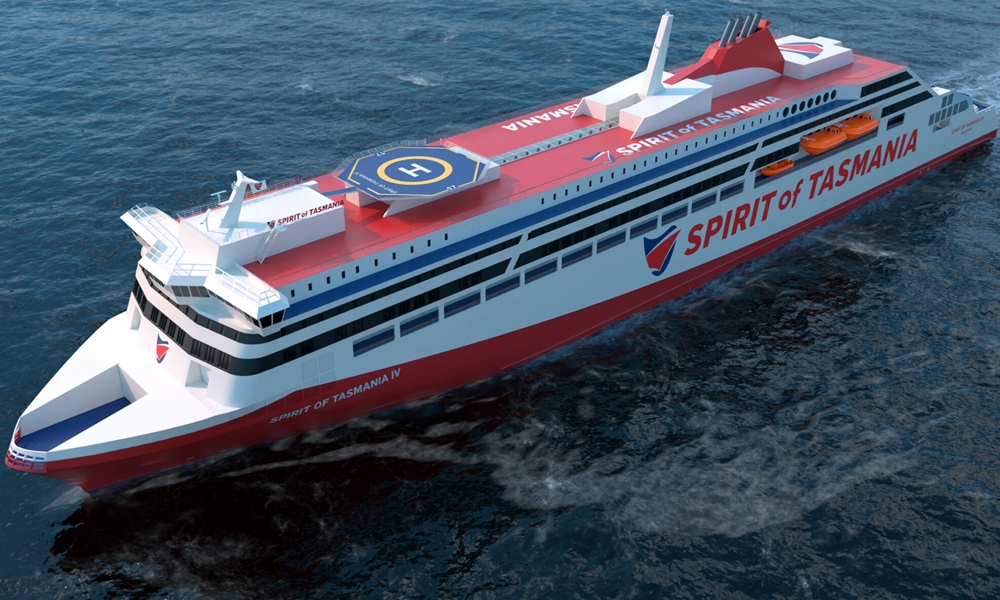
Spirit of Tasmania 4 ferry
Routes: Geelong-Devonport (Victoria-Tasmania)TT-LINE TasmaniaYear build 2024 / Age : 1 Passengers 1800 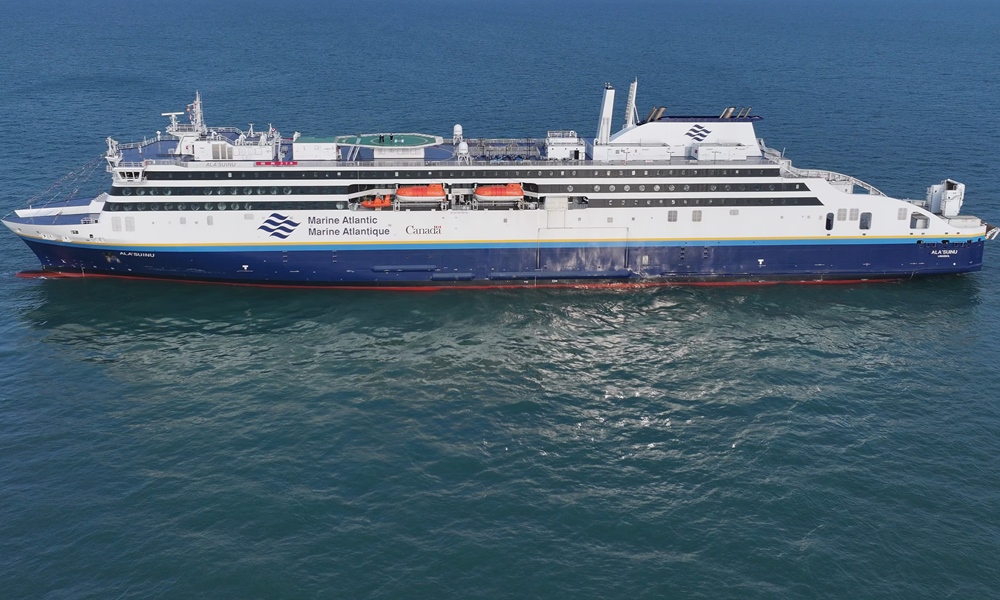
Alasuinu ferry
Routes: Newfoundland-Nova Scotia (Channel-Port aux Basques - North Sydney)MARINE ATLANTICYear build 2024 / Age : 1 Passengers 1100 
Manxman ferry
Routes: Douglas-Heysham (Isle of Man-England), Douglas–Belfast (Ireland)Isle of Man Steam PacketYear build 2023 / Age : 2 Passengers 949 


Santona ferry
Routes: Portsmouth-Cherbourg-Santander/Bilbao, Rosslare-Cherbourg-BilbaoBRITTANY FERRIESYear build 2023 / Age : 2 Passengers 1680 
Finnsirius ferry
Routes: Kapellskar-Langnas (Aland)-NaantaliFINNLINESYear build 2023 / Age : 2 Passengers 1100 - 1212 
Finncanopus ferry
Routes: Kapellskar-Langnas (Aland)-NaantaliFINNLINESYear build 2023 / Age : 2 Passengers 1100 - 1212
Review of Ferries
This is CruiseMapper's hub listing all the world's newest and largest cruise ferry ships. Our list of passenger ferries includes vessels operated by the world's largest ferry companies. The below-listed links are internal and redirect to company's review here. The "routes" and "fleet" links (in brackets by brand) are also internal and show company's vessels and services (homeports/crossing times).
- VIKING LINE, STENA LINE, TALLINK-SILJA LINE, FINNLINES, TT LINE
- DFDS SEAWAYS, P&O FERRIES, BRITTANY FERRIES, IRISH FERRIES
- COLOR LINE, BALEARIA, MOBY LINES, GRIMALDI LINES
- GNV (Grandi Navi Veloci), TIRRENIA, SNCM (Maritima Ferries)
- TRASMEDITERRANEA, CORSICA-SARDINIA FERRIES, CORSICA linea, NAVIERA ARMAS (Canary Islands)
- MINOAN LINES, HELLENIC SEAWAYS, BLUE STAR FERRIES, SUPERFAST FERRIES, SEAJETS FERRIES GREECE
- ANEK LINES, NEL LINES
- BC FERRIES
- Norwegian ferries (COLOR LINE, FJORD LINE, FJORD1 LINE, Hurtigruten, Havila Voyages)
- MOL FERRIES (Japan)
- plus small-fleet companies - DESTINATION GOTLAND, CONDOR FERRIES, POLFERRIES, NORTHLINK FERRIES (Scotland), MARINE ATLANTIC, ECKERO LINE, TT-LINE Tasmania, WASALINE
The Greek company Attica Holdings SA (aka Attica Group, 1918-founded) fully owns as subsidiaries SUPERFAST FERRIES, BLUE STAR FERRIES, HELLENIC SEAWAYS (since 2018) and AML-AFRICA MOROCCO LINK (2016-founded). As of 2021, Attica Group owns and operates 32 vessels connecting 71 ports/islands (in 4 countries), with annual volumes 7+ million passengers, ~1M passenger vehicles, ~0,4M trucks.
Based on FY2016 data, the largest European ferry companies (by fleet tonnage, berths, annual revenue) were ranked as follows:
| Company | Fleet GT (gross tons) | Fleet Beds | Revenue (EUR) |
|---|---|---|---|
| Stena Line | 909,412 | 16,847 | 1,335 billion |
| Grimaldi Lines | 477,667 | - | - |
| Tallink | 466,960 | 18,963 | 945 million |
| DFDS Seaways | 412,722 | - | 1,805 billion |
| P&O Ferries | 409,659 | - | - |
| Viking Line | - | 14,026 | 530 million |
| GNV | - | 13,328 | - |
| Tirrenia | - | 11,876 | - |
| Finnlines | - | - | 511 million |
Ro-Ro ships
RoRo vessels (roll-on / roll-off) as types can be ferries, cruise ferries (with passenger cabins), cargo ships and freight barges. Ro-Ro ships used exclusively for vehicles transportation (cars and trucks) are categorized as PCC ("Pure Car Carriers") and PCTC ("Pure Truck and Car Carriers").
ROPAX ("roll-on / roll-off passenger" is a RoRo ship built for vehicle transport and passenger staterooms (inside and outside). RoRo vessels with capacity 500+ passengers are categorized as "cruise ferries".
Unlike other cargoes measured in metric tons, ro-ro cargoes are wheeled and measured in lane meters (LIMs). LIMs per ship is calculated by multiplying vehicle length (in meters) by the number of cargo decks and by the width in lanes (differs from ship to ship). Most common types of wheeled cargoes on ferries are automobiles, lorries, semi-trailer trucks, trailers, railroad cars. These vehicles are driven on/off the ferry on their own wheels, and some use a platform vehicle (tug master).
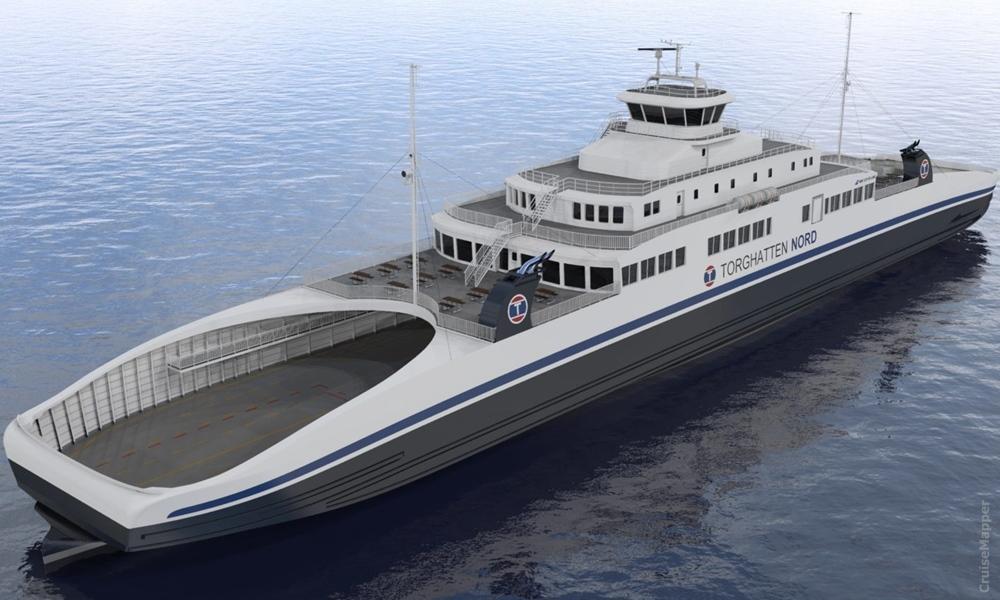
Some vessels are owned by one company and operated under time charter by another. Often, during the ship charter period, the vessel's name is changed.
Ferry types
The legal definition for a ferry is a continuation (prolongation) of a road over a navigable waterway. Ferries as vessels can be categorized as:
- Fast-speed catamaran ferries are generally operated as passenger ships, but the largest of them also carry cars. The most famous catamaran ferry services are in the UK.
- Car ferries are wheeled cargo ships operating on short routes between islands and the mainland. In the USA, car ferries can also carry railway carts.
- RoRo ferries are mainly used in the UK. Most of them are ROPAX ships, and larger vessels are advertised as "cruise ferries" having dedicated bar and seating lounges, as well as passenger cabins.
Double-ended ferry design allows vehicles to be loaded/unloaded via the ship's both ends (bow and stern). Currently, the world's largest double-ended passenger ferries are owned by BC FERRIES. The Coastal-class sisterships Coastal Celebration, Coastal Inspiration, and Coastal Renaissance were all built in Flensburg Germany. Double-ended ferries are used mainly on short routes (including river crossings) as they save maneuvering time and lower fuel consumption (and risks) before docking. A unique feature for such ships is the doubled propulsion (identical units installed at each end). This results in better stopping power and greater maneuverability in comparison to standard ferries.
All RoRo ships have built-in vehicle ramps allowing the wheeled cargo to be rolled on and off the ship when docked in port. Generally, the term "RORO vessel" is reserved for larger ships. Their ramps and entry doors are either stern-only (aft) or bow and stern (forward and aft, for quicker loading).
- Currently, world's largest by tonnage cruise ferry is Color Magic (2007) with 75100 GT, LOA length 224 m, capacity 550 cars, and 1270 lane meter wheeled cargo (75 trucks).
- Currently, the largest by car capacity cruise ferry is Ulysses (2001) with 50938 GT, LOA length 209 m, capacity 1342 cars, and 4100 lane meter wheeled cargo (241 trucks).
Domestic ferries in island countries (especially Asia-Pacific region) are often the only possible (affordable) means of transportation. Their passenger ships navigate inland waterways, as well as on coastal and inter-island routes.
Ferry Terminal
Ferry terminals (aka Passenger Terminal and Cruise Terminal) is a seaport/harbor structure serving cruise and ferry passengers' embarkation (boarding) and disembarkation (landing). Depending on the port, passenger terminals have from one to several docks (wharves or piers) to berth one or more vessels simultaneously.
Automated mooring system by Cavotec
In April 2018 was announced that the engineering company Cavotec (Lugano Switzerland-headquartered) was contracted to install and maintain its automated mooring system MoorMaster at all e-ferry ports in Norway. The project will result in up to 40% CO2 emissions reduction as Norway introduced in 2018 multiple e-ferries. These innovative ships are electrically powered and hybrids (running on LNG and batteries. Many of these ferries already use Cavotec's automated charging interface and vacuum-based auto-mooring technology.
MoorMaster eliminates the need for conventional mooring lines used to secure the ship at berth (after docking). The new system is based on remotely controlled and mounted quayside vacuum pads that moor and release the e-ferries in just seconds. This reduces both emissions and noise at the terminal. The smart technology also reduces overall capital expenditure and improves safety in port.
On December 4, 2018, harbor ferry Suomenlinna 2 (2004-built, 34 m) was successfully remotely piloted in a test area near Helsinki Harbour. The vessel was retrofitted with ABB's Marine Pilot Control (dynamic positioning system) and controlled from Helsinki.
Autodocking system by Wartsila
In 2018 (January through April), the marine engineering corporation Wartsila successfully tested its autodocking technology (world's first). For the tests (harbor docking trials) was used the Norled-owned hybrid ferry Folgefonn and Wartsila-manufactured wireless charging system.
The autodocking system is activated approx 2 km from berth, then the vessel continues at normal speed. The full-automatic system starts the ship's gradual slowing and finally activates its docking maneuver until it is secured at berth. Upon departure, the system can be used in an identical (reverse) manner.
Vessel's maneuvering is automatically controlled by the autodocking equipment and includes both steering and propulsion, with manual control being possible at any time. Among the benefits for the ship, operators are improved safety (less likelihood of human errors), less wear and tear (thrusters are more efficiently used) and better efficiency (allowing more time at berth).
On December 3, 2018, Rolls-Royce Marine demonstrated the world's first fully autonomous ferry on the route Parainen-Nauvo. In May 2018, Rolls-Royce partnered with Finferries for the SVAN project (Safer Vessel with Autonomous Navigation). For the 400 hours of sea trials (in Turku archipelago) was adopted the 54-m long Falco (double-ended car ferry) fitted with numerous sensors and artificial intelligence software. The autonomous cruise was from Parainen to Nauvo, but the return trip was remotely controlled from Turku (approx 50 km away). Additionally was demonstrated Rolls-Royce's autodocking system.
Cruise ferries
Cruise ferry is a Ro-Pax passenger vessel that combines a passenger ship with RoRo vessel ("roll-on / roll-off"). As all cruiseferries have passenger cabins and restaurants, many travelers book them for multi-day "ferry cruises". Ferry's itinerary allows port stays of only a few hours, but you can also stay onboard and never leave the ship until disembarkation day. However, most passengers book ferries as a means of transportation - inside one country or between neighboring countries.
Cruise ferry shipping traffic is mainly concentrated in Northern Europe (Baltic Sea and the North Sea), also in the English Channel (between UK and France), Irish Sea, Mediterranean (including between Italian and French islands, also Europe-North Africa) and in the North Atlantic (serving Spain's Canary Islands, Portugal's Azores Islands, Denmark's Faroes Islands, Iceland, Greenland). Numerous vessels also serve the passenger shipping traffic of China, japan, India, Australia, New Zealand, the USA, and Canada.
Ferries are extremely popular among holiday travelers and private car owners. These ships are among the largest contributors to the vacation tourism growth in Europe, USA-Canada, Asia, Australia-New Zealand.
Ferry cruise deals
All cruise ferries have passenger staterooms that can be booked for overnights. Most ships offer wheelchair-accessible cabins (for disabled passengers). Some even have dedicated "pet-friendly cabins" (for pet owners) and are equipped with kennels (located on garage decks or Sun Deck).
Cruise ferry deals could also include land stays (hotel accommodation or campsite chalets).
Baggage allowance is limited to what passengers can pack in their vehicles.
Passenger cabins are air-conditioned and fitted with en-suite bathrooms. Cabin types include Inside (4-berth, 2-berth) and Outside (2-3-4-berth).
Many hotels offer free stays for kids under 12. Onboard children entertainment programs are often available (usually during peak season) with dedicated supervising staff. Newest and larger ferries have indoor kids playrooms, arcades, video gaming rooms for teens. even a swimming pool.
All large cruise ferries have buffet restaurants, bistros, reserved seating lounges, cocktail bars, patisserie (bakery/coffee shop), boutiques (premium brand shops), elevators (passenger lifts), sundeck areas.
Golf ferry breaks are also popular. Golf tournament breaks are also offered.
Ferry cruise fares are based on departure date, route (itinerary, ports) and time (season). Deposits are required to secure peak season bookings. Prices are higher during peak season (summer), also at weekends and on overnight crossings. Early booking usually offers discounted fares.
Follow our concise reviews of the world's biggest cruise ferry companies, which fleets have the world's largest ferries as both size and capacity.
VIKING LINE
Viking Line (routes, fleet, vikingline.com, 1959-founded, Mariehamn Aland Finland-headquartered) operates on shipping routes connecting Finland-Aland Islands-Sweden-Estonia. Viking Line was formed via the merger of three Finnish ferry lines - Rederi Ab Vikinglinjen, Rederi Ab Slite, SF Line.
In 1970-1974, Viking Line became Northern Baltic Sea's largest shipping consortium, overtaking Silja Line. Back then were launched five sister-ships (by the German shipbuilder Meyer Werft / Papenburg shipyard). In 1973, the line started operations on the ferry route Turku-Mariehamn-Stockholm, competing with Silja Line directly. In 1974, was opened the Helsinki-Stockholm service. In 1985 was launched world's largest (at the time) ferry, MS Mariella, serving the Helsinki-Stockholm route.
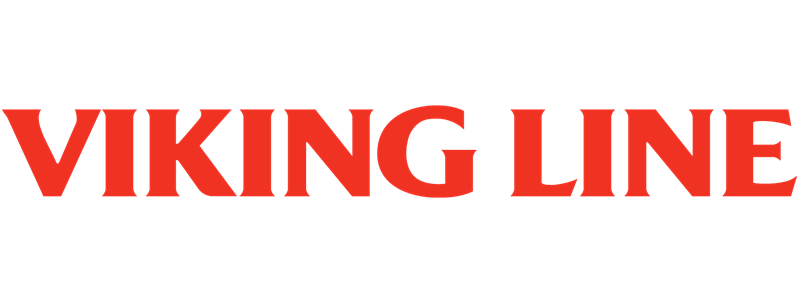
In January 2010 was announced that Viking Line has plans to order a series of two 60,000 GT (LNG-powered) vessels for the Turku-Stockholm route, replacing there Amorella and Isabella. The newbuilds would include many standards for cruise liners features. The projected deliveries were May 2012 and February 2013.
In December 2010, the company signed the official ship order with STX Turku for one cruise ferry (57,000 GT) planned for the route Turku-Stockholm. The new ship (Viking Grace) was launched in August 2012 and started operations in January 2013. The second (optional) sister-vessel from the series was not ordered.
In November 2016, the company signed a letter of intent with the shipyard Xiamen Shipbuilding (China) for building one cruiseferry (Viking Glory/63,000 GT, LNG-powered) to replace Amorella. VIKING didn't exercise the option for a second unit included in the contract (which expired on Jan 1, 2018). In Aug 2022, Amorella was sold to Corsica Ferries.
In 2017, VIKING LINE ferried 6,881149 million passengers. Compared to 2016 (6,502191 million) it was a nearly 6% increase. That number was the ever-highest in the company's history. The number of ferried cargo units was 127,668 and the number of passenger cars - 762253 (all-time record). The greatest increase in passenger shipping volumes was on the route Helsinki-Tallinn (during the summer operated with 12 daily departures) - total 2,34144 million pax (15,7% increase).
On April 12, 2018, Viking Grace became the world's first passenger ship with a rotor sail utilizing wind power and the world's first hybrid vessel that uses both wind power and dual-fuel (diesel-gas) engines. The new China-built ferry (still unnamed, delivery 2020) will be fitted with 2 rotor sails.
In 2019, Viking Line served 6,301 million passengers (6,412M in 2018). Rosella ship alone served 752,336 pax on the route Mariehamn (Aland)-Kapellskar. Cargo units increased to 133,940 (128,549 in 2018) and also passenger cars - to 714,006 (704,799 in 2018). On the Turku-Aland-Stockholm route were served 1,802M pax (1,859M in 2018), on the Helsinki-Tallinn route - 1,956M pax (1,948M in 2018), on the Helsinki-Aland-Stockholm route - 0,972M pax (0,969M in 2018).
In the "COVID 2020" were handled 1,927M pax, increased in 2021 to 2,315M (+20,1%). Wheeled cargo traffic in 2021 was also increased - +2,9% cargo units (129,278) and +24% cars (442,484).
In 2020 were served 1,928M passengers and handled 125,693 cargo units.
STENA LINE
Stena Line (routes, fleet, stenaline.co.uk, 1962-founded, Gothenburg Sweden-headquartered) is the world's largest ferry shipowner and operator. The company provides freight and travel services on Northern Europe's routes that connect UK, Ireland, Denmark, Germany, Latvia, Holland, Norway, Sweden, Poland.
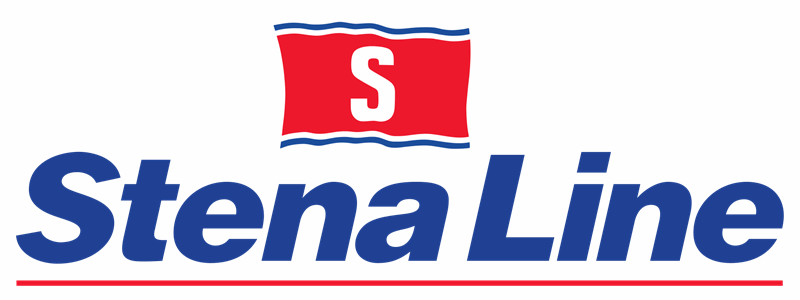
Stena's first operations were Goteborg-Frederikshavn (Sweden-Denmark). In 1972, Stena introduced a computer-based booking system for its cruise ferries. In 1978, the innovative system was implemented for freight ferries. The company owns 3 ferry ports - Holyhead and Fishguard (in Wales) and Cairnryan (Scotland). As of January 2020, STENA employs 2500 people (UK-Ireland). Annually, on its Irish Sea routes (between Ireland and the UK) STENA schedules 326 weekly crossings and transports 2,6M passengers (plus 1,28M wheeled-cargo units).
In 1981, Stena acquired Sessan Line, including its 2 newbuilds (Kronprinsessan Victoria, Prinsessan Birgitta) - the largest ships Stena ships by that time. In 1983 was acquired Varberg-Grena Linjen (operated separately under the Lion Ferry brand until 1997). In 1989 was acquired SMZ (Stoomvaart Maatschappij Zeeland) operating as Crown Line. In 1990 was acquired Sealink British Ferries (owned by Sea Containers), which was rebranded to Stena Line UK and currently operates all Stena ferries on the routes Ireland-UK. In 2000 was acquired Scandlines.
In 1996, Stena launched its 3 high-speed newbuilds (pax capacity 1500) on the routes Belfast-Stranraer, Holyhead-Dun Laoghaire and Hoek van Holland-Harwich. One smaller high-speed ship (pax capacity 900) was launched on the route Goteborg-Frederikshavn.
In 1998, Stena merged its Dover-Newhaven operations with "P&O European Ferries" and formed the joint venture "P&O Stena Line" (40% Stena, 60% P&O). In 2002, PandO bought out Stena's shares and became sole owner of the company, which was renamed to "P&O Ferries".
In November 2006, Stena placed an order for 2 superferries (company's largest, GT 62,000 tons). In 2010, the shipbuilder Aker Yards (now STX Europe) delivered the sisterships Stena Hollandica (May 16) and Stena Britannica (October 9). The new ferries were deployed on the North Sea route Hoek van Holland-Harwich.
In 2010, Stena acquired the Northern Ireland operations of DFDS on the route Belfast-Heysham-Birkenhead. In 2012 Stena launched Superfast 7 and Superfast 8 on the route Belfast-Stranraer. In 2014, Stena acquired Celtic Link's service Rosslare Europort-Cherbourg. On its Irish Sea routes, Stena ferries approx 3 million passengers annually - more than its rivals combined.
In 2012-2017, STENA's Belfast ferry services (to Cairnryan, Birkenhead-Liverpool, Heysham) grew by 15% (car volumes), 13% (passenger traffic) and 19% (freight traffic). STENA LINE operates from Belfast with 7 ships and 22 daily crossings.
In 2017, the company ordered all 6 vessels (sisterships of the E-Flexer series) from AVIC Weihai Shipyard (China). Each has capacity 1000 pax, 120 cars, 3100 lanemeters (210 trailers). Deliveries were planned for 2020-2022.
In June 2018, STENA partnered with Hitachi to implement fleetwide artificial intelligence technology for reducing fuel consumption costs. In 2019 Stena RoRo purchased from Hankyu Ferry (Japan) the ship Yamato (2003-built, IMO 9263150). The vessel was drydock-rebuilt in Europe, then chartered out (2020).
In 2020, STENA permanently closed the Sweden-Germany route Trelleborg-Sassnitz (Rugen Island) and upgraded the Sweden-Germany freight route Liepaja-(Karlskrona)-Travemunde. Celebrating the 25 years of the Holyhead-Dublin/UK-Ireland service (started on November 18, 1995, with Stena Traveller), Stena served 12+ million passengers, ~3 million cars and ~3,5 million freight units. As of 2021, Stena offers 238 weekly UK-Ireland crossings.
In 2020-2021, Stena RoRo drydock-enlarged by 30%, upgraded and renamed two ships (Lagan-Scandica, Mersey-Baltica). Both ferries were deployed on the Sweden-Latvia route Nynashamn-Ventspils. In Feb 2020 was inaugurated the Sweden-Denmark freight service Halmstad-Grenaa.
In 2021-2025 were designed and ordered two fully-electric ships (Elektra and TBN) for the Sweden-Denmark route Gothenburg-Frederikshavn.
STENA is Irish Sea's largest ferry company with the biggest fleet and most Ireland-UK routes (228 weekly crossings). STENA also serves the routes Dublin-Holyhead Wales and Rosslare-Fishguard Wales and has direct service Rosslare-Cherbourg France. The bi-daily service Hanko-Nynashamn (Finland-Sweden) was inaugurated in Jan 2022 and discontinued in Oct 2023.
As of 2021, STENA operates 37 vessels and 37 European ferry routes.
In July 2021, STENA RORO ordered two more (12 total) EFlexer ships from CMI Jinling (Weihai China) with deliveries in 2024-2025. Most EFlexers are long-term chartered to BRITTANY FERRIES (UK-France routes). The new ships' passenger capacity is 1400 and cargo capacity is 2377 lanemeters (EFlexer2024/route Portsmouth-Caen) and 2517 lanemeters (EFlexer2025/route Portsmouth-St Malo).
TT LINE
TT LINE (routes, fleet, ttline.com, 1962-founded, Lubeck Germany-headquartered) is a German shipping company operating Baltic Sea's routes Sweden-Germany (Trelleborg-Travemunde and Trelleborg-Rostock) and Sweden-Poland (Trelleborg-Swinoujscie).
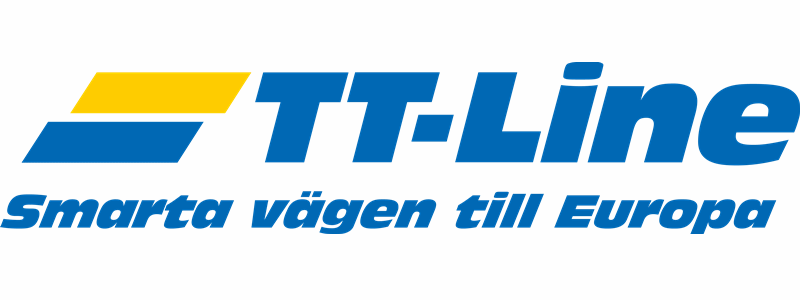
The company's name "TT-Line GmbH" is abbrev from "Travemunde-Trelleborg Line". TT LINE's Sweden-Germany service (Trelleborg-Travemunde) is since 1962. In 1978, the company acquired 50% of Olau Line (Denmark), and the remaining stocks were purchased in 1979. Olau Line was operational between 1956-1994, and between 1974-1994 linked UK and Holland (Sheerness-Vlissingen).
In 1980, TT LINE and Saga Linjen (Swedish State Railways' subsidiary) established the "TT Saga Line" brand. With 6 ships, it linked Travemunde with Trelleborg, Malmo, and Helsingborg. In 1982 the Malmo and Helsingborg services were discontinued, and in 1991 Saga Linjen was closed.
In 1992 started the Trelleborg-Rostock service with 50% stockholder DSR (Deutsche Seereederei). The re-branded company ("TR-Line") was fully acquired in 1996 and renamed "TT-Line".
In 2006, TT-Line's headquarters were moved from Hamburg to Lubeck.
In January 2014 started the Sweden-Poland service Trelleborg-Swinoujscie.
In June 2017 started the Denmark-Poland service Ronne-Swinoujscie.
DFDS SEAWAYS
DFDS Seaways (routes, fleet, dfdsseaways.co.uk, 1866-founded, Copenhagen Denmark-headquartered) operates on shipping routes in Northern Europe (Baltic Sea and the North Sea).
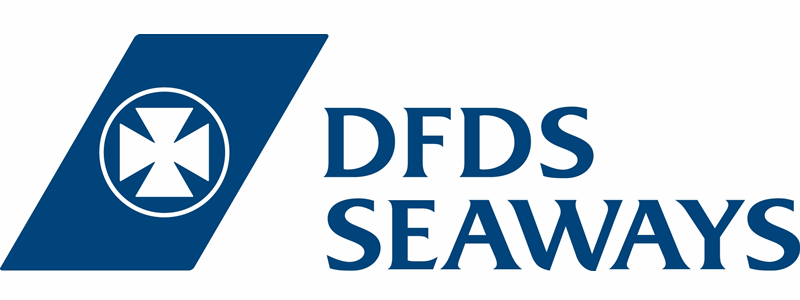
In July 2010, DFDS acquired Norfolkline (Maersk-owned ferry shipping and logistics company) and merged its other divisions ("DFDS Tor Line" and "DFDS Lisco") into "DFDS Seaways".
Norfolkline (1961-founded) provided cargo ferry services in Northern Europe (English Channel, Irish Sea, North Sea), as well as passenger ferry shipping (English Channel, Irish Sea) and logistics services. Upon acquisition, Norfolkline had 2200+ employees and offices in 13 European countries. Norfolkline's fleet consisted of 18 vessels, plus hundreds of trailers (including refrigerated, dry-cargo, swap-body). In 2006, the company handled 1,5+ million ferry passengers on the routes Dover-Dunkirk, Liverpool-Belfast and Liverpool-Dublin.
In February 2012 was launched the route Dover-Calais. In 2015, DFDS changed its logo. The first ships on which hulls it was introduced were Cote des Dunes and Cote des Flandres. The other fleetmates soon lost their name's suffix "Seaways" and were renamed.
2017 was a record year with operating profit of DKK 2.7 billion. The increased volumes were partially based on DFDS' 10 North Sea freight routes (+7% over 2016). In 2017, the company ordered 4 RoPax newbuilds (capacity 475 trailers each) specifically for North Sea crossings. The ferries were ordered to the Jinling Shipyard (China) with scheduled deliveries 2019 and onwards.
In 2018, DFDS invested around DKK 100 million (USD 16,5 million) in further development of the company's digital capabilities, new online booking systems (serving passenger-shipping-logistics), new mobile apps (serving passengers-drivers-freight customers).
On April 12, 2018, DFDS acquired 98,8% of Turkey's largest freight shipping company "UN Ro-Ro Anasayfa" for EUR 950 million. UN Ro-Ro serves 5 Mediterranean routes connecting Turkey with Greece (Patras), Italy (Trieste, Bari) and France (Toulon), 12 vessels, 3 port terminals (Trieste, Ambarli, Pendik-Istanbul), annual revenue EUR 240 million and around 500 employees.
In 2018, DFDS and STENA signed a 10-year bareboat charter deal for Cote d'Opale (modified E-Flexer) starting Dover-Calais crossings in June 2021.
In May 2019, DFDS and Stora Enso Oyj (1998-founded Finnish manufacturer of paper-pulp-forest products-biomaterials) signed a 5-year agreement (+3y optional) for shipping ~700,000 tons of cargo via DFDS ships on new Sweden-Belgium route Goteborg-Zeebrugge/Ghent. Stora Enso's annual sales are ~EUR 10,5 billion. The Goteborg-Zeebrugge line was opened in June 2019, with 3 ships and 5 weekly departures (in each direction).
On January 2, 2021, started the direct Ireland-France service (Rosslare-Dunkirk) with 6 weekly crossings.
In Dec 2022, DFDS acquired (100% ownership) McBurney Transport Group (1965-founded, based in Ballymena, Northern Ireland) specializing in trailer-based logistics by road and ferry between Ireland and the UK.
In September 2023, DFDS acquired FRS Iberia/Maroc (2000-founded division of FRS GmbH & Co KG). FRS Iberia groups three independent companies (operating under the Maroc brand). It manages three short routes interlinking Spain and Morocco via Gibraltar Strait (Tarifa-Tangier, Algeciras-Ceuta, Algeciras-Tanger Med) with 7 vessels. The passenger ferries are fast-speed/with catamaran-design hulls. As of 2023, Maroc has ~30% market share in the Gibraltar Strait ferry crossings.
In May 2024 was announced the sale of the Oslo-Copenhagen route to Gotlandsbolaget/Rederi Gotland AB.
BRITTANY FERRIES
Brittany Ferries (routes, fleet, brittanyferries.com, 1972-founded, Roscoff France-headquartered) is a French company serving the shipping routes France-UK and France-Spain. Brittany Ferries is among the largest ferry and cruise tour operators from UK and Ireland to France and Spain. Deals are bookable through travel agents and directly online (except golf breaks).
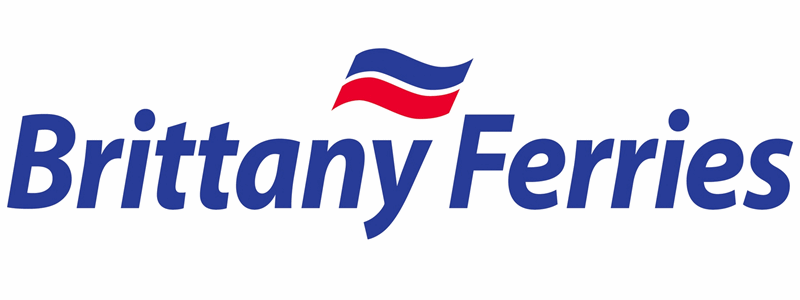
Brittany Ferries started operations in January 1973 with the Plymouth-Roscoff service, soon expanded with the lines to Saint-Malo, Santander, and Cork. In 1985 was acquired Truckline Ferries (freight-only operator with 2 ships serving Poole-Cherbourg. In 1986 were introduced the routes Caen-Portsmouth and Caen-Poole. In 1989 started the Cork-Santander service.
In 2001 was added the fast-ferry service Poole-Cherbourg via a partnership with Condor Ferries. Freight-only services were started in 2007 (Poole-Cherbourg), 2009 (Poole-Santander) and 2016 (Poole-Bilbao). In 2011 was inaugurated the Portsmouth-Bilbao line. On May 13, 2011, was officially opened the Portsmouth Continental Ferry Port - a new terminal used by cruise companies, Condor Ferries (to Channel Islands) and Brittany Ferries. In May 2013 was introduced the route Portsmouth-Le Havre/Paris.
In 2018 were confirmed two STENA LINE-charter deals for two Stena E-Flexer class ships (Galicia, Salamanca), with buy-option after their 5-year charters. In April 2018 was started the Cork-Santander line (2020-terminated). In October was revealed a new logo to be implemented fleetwide during drydocks in 2018-2019-2020.
As of 2018, Brittany Ferries operates 12 liners/11 routes and has annual capacity is ~2.5 million passengers (85% British) plus ~210,000 wheeled freight units. In 2018, it invested GBP 450M in fleetwide renovations plus three LNG-powered E-Flexers.
In March 2020, Brittany Ferries and Columbia Threadneedle ESIF (European Sustainable Infrastructure Fund) finalized the acquisition of Condor Ferries. The company was purchased from MIRA (Macquarie Infrastructure and Real Assets) which is part of MGL-Macquarie Group Ltd (Australian investment bank and financial company).
Since March 2021, Brittany Ferries operates the Ireland-France route Rosslare-Cherbourg as part of the 2020-launched service Rosslare-Bilbao (Ireland-Spain). Also since March 2021, the company chartered MS Cotentin for the route Portsmouth-Le Havre.
The company sells the following 4 main products (all are ferry travel-inclusive):
- Land Accommodations (cottages and villas in France and northern Spain)
- Hotel Breaks (to France, Spain, and Portugal, including the hotel- chains Paradores and Pousadas, car tours, B&B hotels, apartment rentals in Portugal and southern Spain)
- Family Holidays (apartments, chalets on 5 campsites in northern Portugal, holiday resorts in France and northern Spain)
- Golf Breaks (courses in France and northern Spain)
On October 24, 2016, the company announced plans to build a new LNG-powered cruise ferry for the UK-France route Portsmouth-Caen. On December 21, 2016, was released the vessel's design (project "Mont St Michel 2") - capacity 1680 passengers and 550 cars (or 130 freight vehicles) and gross tonnage 42,000 tons. The shipbuilder is Flensburger Schiffbau-Gesellschaft (shipyard Flensburg Germany) - scheduled delivery April 30, 2019.
In May 2018 was started (the first ever) direct link Ireland-Spain (Cork-Santander) with 2 weekly return-crossings, plus 1 weekly return-crossing from Cork to Roscoff. In 2018, the company also celebrated its 40th year of operations in Ireland (since 1978, on the route Cork-Roscoff).
The company's 2019 schedule was expanded with 19 more weekly return-crossings to 3x English Channel - Roscoff to Plymouth, Cherbourg to Poole and Le Havre to Portsmouth. As requested by the UK's Department for Transport, the additional crossings increased the company's freight capacity by ~50%, and cross-channel's overall capacity by 30%.
In mid-November 2019, Brittany Ferries and ESIF (Columbia Threadneedle European Sustainable Infrastructure Fund/equity fund part of Columbia Threadneedle Investments UK) signed an agreement to acquire Condor Ferries from MIRA (Macquarie Infrastructure and Real Assets Ltd). The company was owned by MIRA via its subsidiary Commodore Group (part of Macquarie Group).
Annually, the company serves ~2,5 million passengers and ~210,000 freight vehicles.
BC FERRIES
BC FERRIES (routes, bcferries.com, 1960-founded, Victoria BC Canada-headquartered) is a Canadian state-owned company. "British Columbia Ferry Services Inc" provides daily scheduled passenger and vehicle (RoPax) ferry services between mainland Canada and British Columbia (BC) islands. BC's inland ferries (on lakes and rivers) are run by the state's Ministry of Transportation.
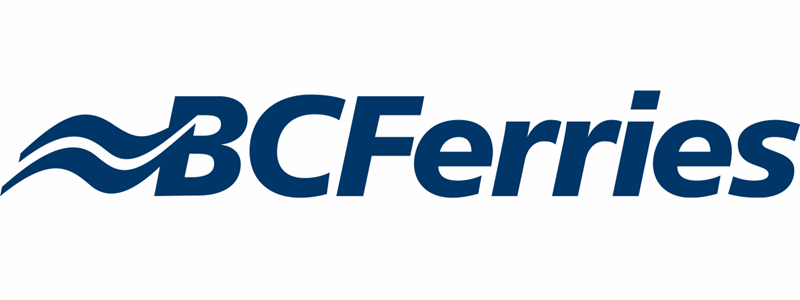
Currently, the company is ranked North America's largest (followed by "Washington State Ferries") and world's 3rd largest passenger ferry line.
In 2008, the company launched three Coastal-class vessels (the sisterships Coastal Renaissance, Coastal Inspiration, Coastal Celebration) ranked as the world's largest double-ended passenger ferries (max capacity 1650 pax, 370 cars). Fleet's largest by passenger capacity (2100 pax, 358 cars) are the two Spirit-class ships (Spirit of British Columbia, Spirit of Vancouver Island).
In April 2018 was reinstituted the seniors discount - passengers 65+ yo travel for free (Monday through Thursday) on most routes.
On October 5, 2018, the company issued an REOI (Request for Expressions of Interest) for the building of 5 new ships. The competitive bidding was open to shipyards worldwide. The newbuilds will enter service in 2023 on the routes Metro Vancouver-Vancouver Island.
In March 2019, BC Ferries announced plans for building up to 5 new ships - replacing 4 existing ones (New Westminster, Alberni, Coquitlam, Cowichan) and adding capacity to the route Metro Vancouver-Vancouver Island. The newbuilds enter service in mid-2020.
BC FERRIES' current fleet consists of 36 vessels (total capacity 27,000+ passengers and crew) and serves 47 locations along BC Canada's coast. Fleet's car capacity ranges from 16 to 470 (superferries). In 2008-2018, BC Ferries spent CAD 1+ billion at the BC Canada shipyards Vancouver Drydock (Seaspan), Point Hope Maritime (Victoria BC), Esquimalt Drydock (Esquimalt BC), Esquimalt Graving Dock (Victoria BC), Allied Shipbuilders (North Vancouver), Deas Dock (Fleet Maintenance Unit, Richmond BC). BC Ferries contracts local suppliers for fleetwide upgrades, including repairs, drydocking, refits. BC Ferries spends ~$200 million annually on ships, port terminals, and technologies generate ~$100 million in Gov taxes, supports 5100+ local jobs.
PO FERRIES
P&O Ferries (routes, fleet, poferries.com, 2002-founded, Dover England-headquartered) operates on the shipping routes UK-France, UK-Ireland, UK-Holland (mini-cruises), UK-Belgium (mini-cruises) and Scotland-Northern Ireland.
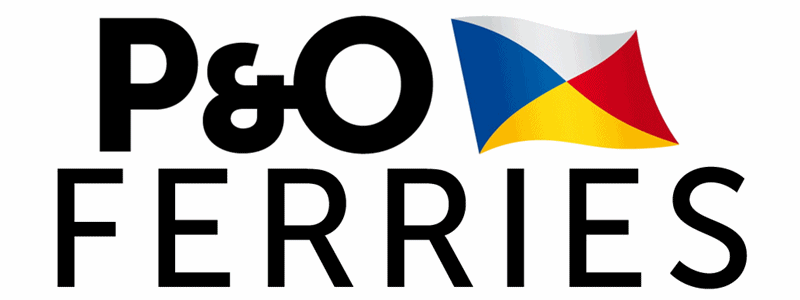
In 2006, P&O Group was sold to DP World - a Dubai-based company that owns and operates inland- and seaport terminals worldwide, also specializes in maritime services and logistics. In 2006, DP World bought P&O Group but sold P&O Ferries to Dubai World Holding (its majority shareholder) as DP World focused on container terminal operations. In February 2019, DP World reacquired P&O Ferries for GBP 322 million (UAE dirham 1,5 billion).
In September 2010 was closed the ferry route Portsmouth-Bilbao, which coincided with the Pride of Bilbao (now Princess Anastasia) ship charter's ending. This was the last PO service from Portsmouth, following the closures of the routes Portsmouth-Cherbourg and Portsmouth-Caen (in 2004) and Portsmouth-Le Havre Paris (in 2005).
The cheapest P&O mini-cruise ferry deals are 3-day / 2-night voyages from the UK to Holland and Belgium. Themed as "city breaks", PO mini cruise deals offer roundtrip departures from Hull to either Rotterdam (Amsterdam) or Zeebrugge (Brugge). Longer city breaks (duration up to 7 days / 6 nights) offer roundtrips to Hamburg (Germany), Bilbao (Spain), and La Rochelle (France). On mini cruises from the UK, P&O ferry passengers receive boarding cards (doubling as meal vouchers), cabin keycards and booklets with vouchers (for return check-in and bus transfers / if any). Boarding card with a suitcase icon on it means passengers can leave their luggage in the stateroom while disembarking the ship. This feature, however, must be confirmed at check-in.
In June 2018, PandO increased by 1/4 its freight shipping capacity (to about 125,000 units annually) on the Belgium-UK route Zeebrugge-Teesport. Teesport (owned by PD Ports) opened a new rail connection to Mossend (near Glasgow England).
In February 2019, DP World PLC (Dubai) acquired P&O Ferries (pan-European logistics) and P&O Ferrymasters (supply chain solutions in Europe) for GBP 322 million (USD 421m). PO Ferries' FY2017 reports included revenue GBP 1,1 billion (USD 1,4bn) and EBITDA GBP 100 million (USD 131m).
In 2019-2020, the company will build Tilbury2 ferry terminal - an exclusive deepwater berth at Thames River. The new terminal (building cost GBP 150 million) has annual freight capacity of 600,000 units. The facility is at 152 acres site (part of former "Tilbury Power Station") and linked directly to A13 (via new road).
In April 2021, P&O sold the ships Pride of Bruge and Pride of York to GNV, after terminating the Hull-Zeebrugge service in January.
In December 2023, P&O discontinued the Dublin-Liverpool service Liverpool's berth lease was not extended by the port owner. This decision impacted 24 weekly UK-Ireland crossings.
TALLINK-SILJA LINE
Tallink-Silja (routes, fleet, tallinksilja.com, 1989-founded, Tallinn Estonia-headquartered) is ranked by fleet tonnage and capacity as Baltic Sea's largest. These are actually two brands - Tallink (parent company) and the subsidiary Silja Line.
Tallink-Silja ships connect directly Estonia with Finland and Sweden. there are also direct connections from Sweden to Finland and Latvia.
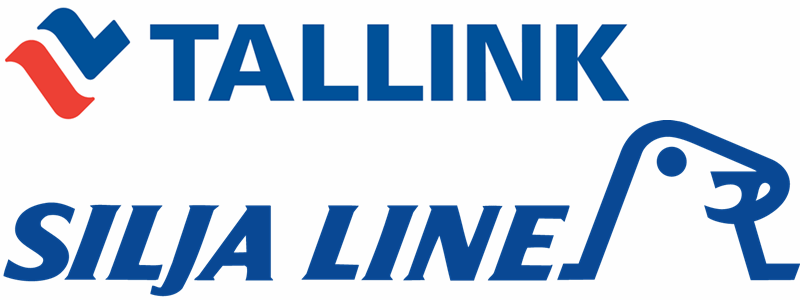
Currently, Tallink-Silja deals offer 1-2 overnight cruises, hotel, and travel packages, city breaks, daily passenger and cargo shipping and high-speed ferry shuttle services.
The company's history goes back to the USSR's (Soviet Union) times when in 1965 was established the Estonian Shipping Company to provide passenger ferry service on the route Helsinki-Tallinn. Year-round operations started in 1968.
In 2006, AS Tallink Grupp purchased from Attica Group the Baltic services of Superfast Ferries for EUR 310 million. Then was opened the route Riga-Stockholm. Also in 2006, Tallink purchased from Sea Containers Ltd the Finnish company Silja Line for EUR 470 million.
In August 2011, STENA chartered 2 ships (Superfast 7, Superfast 8) through 2014 for Scotland-Northern Ireland routes.
In 2014, Tallink's asset base EUR 1,7 billion, of which EUR 1,02 billion in newbuilds and EUR 780 million in acquisitions. The loans were EUR 440 million. The company's annual spending on ship refurbishments and fleet upgrades are around EUR 30 million.
In February 2015 was signed the shipbuilding contract with Meyer Turku for Megastar (2017) and in March 2018 with RMC-Rauma for MySTAR (2022). Both newbuilds are fleet's largest (GT 50,000), LNG-powered and with passenger capacity 2800 (each).
In 2016, Tallink operated a fleet of 16 vessels and 5 hotels. Tallink's annual revenue was EUR 938 million, number of employees 7000, annual passenger capacity 9,5 million, annual cargo capacity 328000 units. Of the total revenue, over 1/2 is from restaurant and duty-free shop sales, and 1/4 from ticket sales.
FY2017 Tallink Grupp ferried 9,755720 million passengers (+3,2% over 2016) and total 364,296 wheeled cargo units (+11%). The Estonia-Sweden route served 1,013007 million passengers. The Latvia-Sweden traffic increased 45,8%. The Estonia-Finland traffic increased 11,6%.
In FY2019, Tallink Grupp served a record 9,763210 million passengers (+0,1% over 2018's 9,756611 million). The number included 2,894494M (Finland-Sweden routes), 5,115602M (Finland-Estonia), 0,799961M (Latvia-Sweden), 0,953153M (Estonia-Sweden).
Since September 2020, Tallink-Silja operates the Tallinn-Mariehamn Aland-Stockholm route with 2x ferries (Baltic Queen and Victoria I) and 2x return trips weekly. Departures are from Tallinn (D-terminal) and from Stockholm (Vartahamnen).
FINNLINES
Finnlines (routes, fleet, finnlines.com, 1947-founded, Helsinki Finland-headquartered, part of Grimaldi Group) provides passenger and ro-ro ferry services predominantly in Northern Europe (Baltic Sea and the North Sea).
Finnlines' ships connect the countries Finland, Russia, Sweden, Germany, Poland, Denmark, Holland, Belgium, UK, Spain.
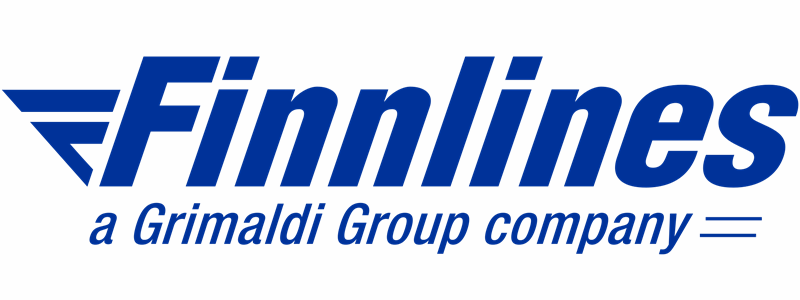
The company was founded as a Merivienti Oy ("Sea Export Ltd") subsidiary for Transatlantic freight (mainly forest industry products) service between Finland and USA. The passenger ferry service started in 1962 on the -Finland-Sweden-Germany route Hanko-Visby-Travemunde.
In 1973 was ordered the Wartsila Helsinki shipyard-made ship GTS Finnjet - at the time world's largest and fastest ship (GT 24605 tons, length 213 m, speed 31kn / 57 kph / 36 mph). The vessel entered service in May 1977 on the route Helsinki-Travemunde (crossing time was 22 hours).
In 2004, the brands Finnlink and NordoLink were merged into Finnlines. Also in 2004 were placed shipbuilding orders for 5 large Star-class ferries (from Fincantieri, Italy - shipyards Ancona and Castellammare di Stabia) delivered in 2006 and 2007. In August 2007, Finnlines ordered 6 new ice-classed ships (from CSC Jinling Shipyard, Jiangsu China), with planned deliveries in 2010 and 2011.
In the period 1999-2001 were delivered the 4 Seapacer-class ships (built by Astilleros Espanoles in Cadiz / Puerto Real shipyard) - Finnclipper, Finneagle, Stena Britannica (Finnfellow) and Stena Germanica - all with ice-strengthened hulls.
In January 2007, Finnlines' largest shareholder Grimaldi Group expressed its intention to purchase the entire company. Grimaldi completed Finnlines acquisition (100% ownership) in August 2016.
In the period October 2017-May 2018, Finnlines completed a ship lengthening project for all 6 ice-class "1A" RoRo vessels of the "Finnbreeze series" (Finnsky, Finnsun, Finntide, Finnwave, Finnbreeze, Finnsea). Each of these Nanjing China-built vessels was enlarged by adding an approx 30 m long midship section. Following the EUR 90 million budgeted vessel reconstruction program, each ship's capacity was increased by 30% (from 3291 to 4213 lanemetres). The drydock refits were done at Remontowa shipyard (Gdansk Poland).
For FY 2017 (fiscal year) Finnlines Group reported a record year with over 21% increase (over 2016) or EUR 82,7 million revenue. Finland's sea freight volumes in 2017 grew by 12%. In the period 2007-2017, the company spent EUR 1+ billion on fleet renovation and port infrastructure projects.
In May 2018, Finnlines and CSC Jinling Shipyard (China) signed a shipbuilding contract for 5 ships (3x Ro-Ro plus 2x Ro-Pax) with scheduled deliveries 2021-2023 and total cost ~EUR 500 million.
In May 2018 started the direct/weekly cargo service Helsinki-Aarhus (Denmark), connecting with Turku via Travemunde. Departures from Helsinki are on Thursdays, Sundays departures from Helsinki to Aarhus are via Travemunde (arrival Tuesday morning).
COLOR LINE
Color Line (routes, fleet, colorline.com, 1990-founded, Oslo Norway-headquartered) operates on passenger and cargo shipping routes between Norway and Sweden, Germany and Denmark.
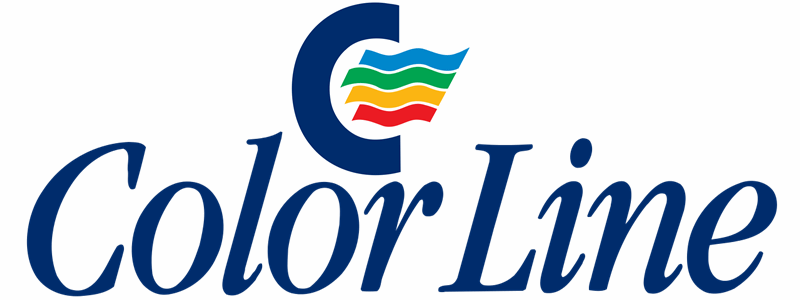
Color Line is Norway's largest cruise ferry operator (as fleet capacity) and also one of Europe's leading companies in terms of fleet age (all newbuilds/the year 2000 onward) and shipboard amenities (staterooms, shops, bars, restaurants, lounge entertainment).
The company has offices in Norway (Oslo / main, Kristiansand, Sandefjord, Larvik), Germany (Kiel), Denmark (Hirtshals) and Sweden (Stromstad).
The company was established following the 1990 merger of the Norwegian ferry companies Jahre Line and Norway Line. Jahre Line operated on the route Oslo-Kiel since 1961. Norway Line operated since 1986 on routes connecting Norway with the UK and Holland Also in 1990, the newly formed Color Line acquired Fred Olsen Lines along with hits operations between Norway and Denmark.
In the 1990s the company expanded its fleet by buying larger second-hand ferries In October 1996. Color Line acquired Larvik Line and its Norway-Denmark services. In September 1998 were acquired the companies Color Hotel Skagen and Scandi Line (operating on short Norway-Sweden routes). At the end of 1998, Color Line sold its Norway-UK operations to FJORD LINE. In 1999 was acquired Scandi Line (renamed Color Scandi Line).
The 2000s were company's fleet renovation period when were launched Color Fantasy (2004), Color Magic (2007), Superspeed 1 (2008) and Superspeed 2 (2008). In May 2008 the Oslo-Hirtshals route was officially closed.
In January 2017, Color Line signed a letter of intent with the shipyard Ulstein Verft (Ulsteinvik Norway) for building a new cruiseferry (Color Hybrid) for the route Sandefjord-Stromstad. To support the liner, COLOR LINE installed in 2017 shore-to-ship power facilities in Oslo, Kristiansand, Larvik and Sandefjord, where the ship's batteries can be charged.
Since January 1, 2019, the Norway-Germany route (Oslo-Kiel) is served with 3 weekly roundtrips by Finncarrier (freight RoRo ship, capacity 1775 lane meters / 120 trucks) and the cruise ferries Color Magic and Color Fantasy.
Currently, COLOR LINE is the only cargo-passenger shipping company with Norwegian-flagged vessels serving international traffic with regularly scheduled crossings to/from Norway.
MOBY LINES
Moby Lines (routes, fleet, mobylines.com, 1959-founded, Milano Italy-headquartered) operates on shipping routes connecting mainland Italy and France with the Mediterranean islands Corsica, Elba, and Sardinia.
The company is best known for using for its ships' interior decorations Warner Bros patented Looney Tunes characters.
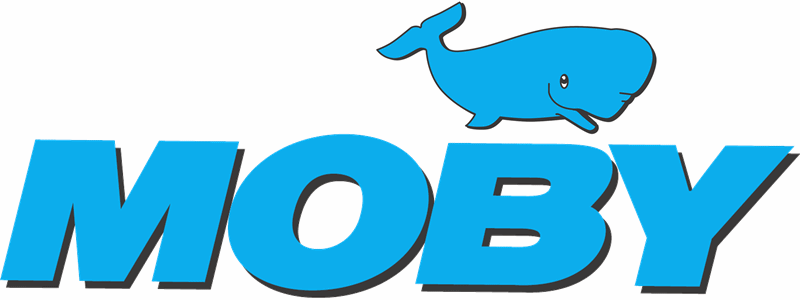
Since 1996, Moby's fleet was radically expanded with newbuilt, larger and faster vessels.
In 2003, the parent company (shipowner) Onorato Armatori SpA signed an exclusive agreement with Warner Bros (a division of Time Warner Corporation) to paint largest Moby ships' hulls with Looney Tunes-themed liveries.
In February 2018, MSC Group and MOBY LINES signed a shipbuilding contract with the Chinese companies GSI (Guangzhou Shipyard International) and CSTC (China Shipbuilding Trading Co) for 4x units. Each ship has passenger capacity 2500, cargo capacity 3800 lanemeters (1300 cars or 3000 trailers), length 237 m, speed 24 knots. The contract includes the option for an additional 4 ships of the same design. Two of the newbuilds (1st and 3rd) are for GNV, the other two (2nd and 4th) - for MOBY LINES.
GRIMALDI LINES
Grimaldi Lines (routes, fleet, grimaldi-lines.com, 1999-founded, Civitavecchia Italy-headquartered) operates mainly on Mediterranean shipping routes connecting mainland Italy with Sardinia, Sicily, Spain, Greece, Morocco, Tunisia.
The company is a subsidiary of Grimaldi Group (1947-founded).
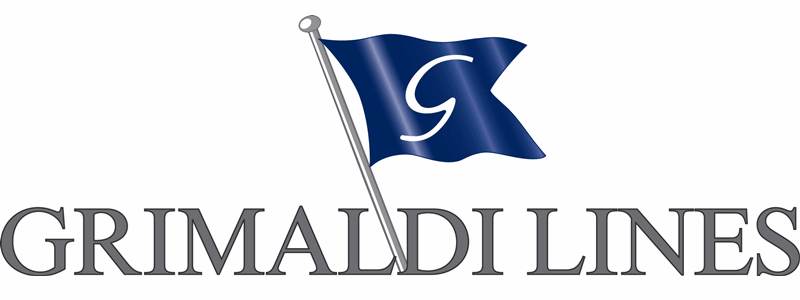
The company was founded for shipping services within the "Autostrade del Mare" ("Motorways of the Sea" - development project aiming to improve the European Union's maritime transportation links.
The company started the first freight ferry connections between Italy, Spain, and Malta, and since 2000 carries passengers on routes connecting Italy (ports Civitavecchia and Salerno) with Sicily (Palermo), Spain (Barcelona), France (Toulon), Corsica Island (Porto Vecchio) and Tunisia (Tunis). With the years were added lines to Sardinia Island, Greece, and Morocco.
In 2021, Grimaldi won the tender for route Naples-Cagliari Sardinia-Palermo Sicily. Operated with MS Corfu (960-pax), the twice-weekly service offers departures from Naples (Mondays and Fridays, at 7 PM), Cagliari (Thursdays, at 7 PM) and Palermo (Wednesdays, at 7 PM).
GNV (Grandi Navi Veloci)
Grandi Navi Veloci (routes, fleet, gnv.it, 1992-founded, Genoa Italy-headquartered) owns ferries connecting mainland-Italy with Sicily, France, Sardinia, Albania, Morocco, Tunisia.
The company was founded by Aldo Grimaldi as a Grimaldi Group subsidiary, with operations since 1993 (Genoa-Palermo Sicily route).
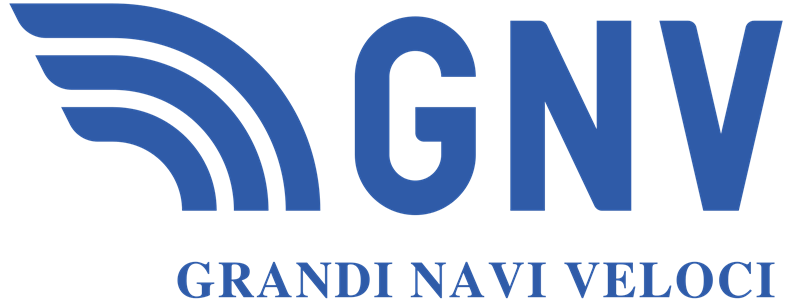
The sisterships Majestic (1993) and Splendid (1994) were the first-ever Italian cruiseferries.
In the following years were introduced more vessels, serving the routes Livorno-Palermo, Civitavecchia (Rome)-Palermo, Genoa-Olbia (Sardinia Island), Genoa-Barcelona (Spain).
GNV's ships La Superba (2002) and La Suprema (2003) were the Mediterranean's largest at that time.
The fleet expansion in 2008 added 3 ro-ro cargo vessels (Audacia, Tenacia, Coraggio) serving the newly opened Genoa-Barcelona-Tangier route.
In 2009, GNV became fully independent from Grimaldi Group, and in 2010 was acquired by MSC Group. In 2010, GNV merged with SNAV (Societa Navigazione Alta Velocita/also an MSC subsidiary). In 2012 were opened new routes Italy-France (Sete) and Italy-Morocco (Tangier, Nador).
In December 2014, Grimaldi Holding sold the ship Audacia to the Hong Kong-based Rizhao Port Shipping Company Ltd. The boat (renamed "Rizhao Orient") serves the China-South Korea route Rizhao-Pyeongtaek. In 2015 was opened the Italy-Albania (Durres-Tirana) route.
In February 2018, MSC Group and MOBY LINES signed a shipbuilding contract with the Chinese companies GSI (Guangzhou Shipyard International) and CSTC (China Shipbuilding Trading Co) for 4 new luxury cruise ferries. Each ship has passenger capacity 2500 (536 cabins), cargo capacity 3765 lanemeters (750 cars or 250 trailers), length 230 m (755 ft) and speed 24 KN. The contract includes the option for an additional 4 ships of the same design. Two of the new ships (1st and 3rd) are for GNV, the other two (2nd and 4th) - for MOBY LINES. The first ship's delivery was scheduled for 2020. Both Chinese shipbuilders are subsidiaries of the state-owned corporation CSSC (China State Shipbuilding Corporation).
In April 2021, P&O Ferries sold the ships Pride of Bruge (Antares) and Pride of York (Aries) to GNV, after terminating the Hull-Zeebrugge service in January. Also in 2021 GNV bought the ship Sealand (fka Scottish Viking) and chartered GNV Bridge.
In January 2022, MSC ordered for GNV 4x cruiseferries (1500 pax / 303 cabins) from the shipbuilder CSI-Guangzhou Shipyard International (China). Deliveries are scheduled for 2024-25-26-27.
TIRRENIA di Navigazione
Tirrenia Navigazione (routes, fleet, tirrenia.it, 1936-founded, headquartered in Naples Italy and Cagliari Sardinia) is a privately-owned company contracted by Italy's Ministry of Transportation to provide regularly scheduled shipping services between mainland Italy and the country's main islands.
The company serves exclusively domestic routes.
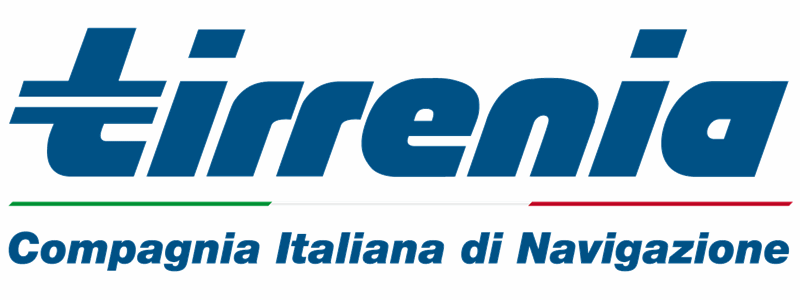
The company was founded following the 1936 nationalization of privately-owned Italian shipping lines. After WW2 (1939-1945), its few surviving vessels were used to interlink the largest Italian islands (mainly Sardinia) with mainland Italy.
On December 23, 2009, the company was put on the market. Among the 16 bidding companies were SNAV, GNV, Grimaldi Lines, Moby Lines, Corsica-Sardinia Ferries, Mediterranea Holding. The latter ended up alone when al other bidders quit, and on July 28, 2010, won the bidding for Tirrenia and its subdivision Siremar (Sicilia Regionale Marittima). On August 4 was announced that the sale is off as Mediterranea Holding didn't show up for the signing.
Until 2010, Siremar served the routes between Sicily and the Italian islands Aeolian, Aegadian, Ustica, Lampedusa and Pantelleria.
In November 2008, the Italian government started procedures for Tirrenia's privatization. On May 18, 2011, the second purchase tender was won by CIN (Compagnia Italiana di Navigazione). CIN was a new company (formed specifically for Tirrenia's privatization), composed of Grimaldi Group, Moby Lines (Vincenzo Onorato) and Marinvest (Gianluigi Aponte). In April 2012, CIN and private investors (Alexis Tomasos) won the tender and on June 21, the state-owned company was officially privatized. The EU Antitrust Authority's decision to agree with CIN's dominant position led to the exit of Grimaldi Group, Moby Lines and Alexis Tomasos. On July 19, CIN officially became the company's owner.
Annually, Tirrenia Navigazione makes numerous crossings (around 60,000) by newbuild, high-speed ferries. The annual number of served passengers is around 13 million, ferried cars are around 2 million. Fleet's annual mileage is also impressive - around 6.5 million km (4 million mi). On the most popular routes, ships' capacity is ~2700 passengers (900 cars). During summer (high season), these boats cruise at speeds up to 55 kph / 35 mph.
IRISH FERRIES
Irish Ferries (routes, fleet, irishferries.com, 1992-founded, Dublin Ireland-headquartered) is a division of ICG (Irish Continental Group) operating passenger and freight shipping on routes between Ireland, UK, and Europe.
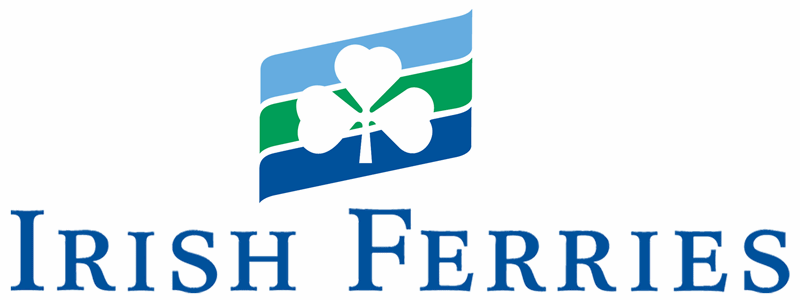
ICG (1972-founded as Irish Continental Line) also operates terminal facilities in Dublin (Ferryport Terminals) and Belfast (Container Terminal). Until 1992, when ICG acquired the state-owned B&I Line (British and Irish Steam Packet Company), ICG operated only on routes between Ireland and Europe. Following the acquisition of B&I Line, services were expanded to include short links Ireland-UK. ICG's container shipping and port operations were also extended. Company's fleet was fully modernized by replacing all existing vessels with newbuilds (a EUR 500 million investment project).
In 2016, ICG signed an agreement with the shipbuilder FSG (Flensburger Schiffbau-Gesselschaft) for a future cruise ferry building order. At contract price EUR 144 million, the new ship (scheduled delivery May 2018) is designed with pax-crew capacity 1885, 435 cabins (4 cabin decks, balcony suites), 165 freight vehicles (2800 lane meters), additional car deck (total capacity 300 cars). The new ship will have bars, restaurants (a la carte and self-service), Club Class passengers dedicated lounge (direct access from car decks), 2 cinemas, freight drivers-only facilities, retail shops, pet facilities. The ship will be powered by 4 diesel engines (total power output 33,6 MW.
After WB Yeats ship delivery, the shipbuilder Flensburg started building a second / larger cruise ferry scheduled for delivery in 2020. The newbuild was commissioned in mid-January 2018 by the parent company Irish Continental Group, at contract price EUR 165,2 million.
Since April 2021 (with the chartered from Attica Group Blue Star 1) is operated the Ireland-Wales route Rosslare-Pembroke Dock.
Since June 2021 (with Isle of Inishmore) is operated the new England-France route Dover-Calais. The ship is currently chartered to Interislander (KiwiRail, New Zealand) under the name "Kaitaki". In January 2018, HSC Jonathan Swift (fast catamaran ferry, aka Dublin Swift) was sold to Balearia for EUR 38,8 million. The catamaran was operated on the Dublin-Holyhead route between 1999-2017. It was replaced by Westpac Express (2001-built high-speed catamaran).
BALEARIA
Balearia Eurolineas Maritimas (routes, fleet, balearia.com, 1998-founded, Denia Spain-headquartered) operates on Mediterranean shipping routes connecting mainland Spain with the Balearic Islands. Departures are from Barcelona, Denia, Valencia.
The company also operates routes passing Strait of Gibraltar, with departures from Algeciras to Ceuta (Spanish Morocco) and Tangier (Morocco).
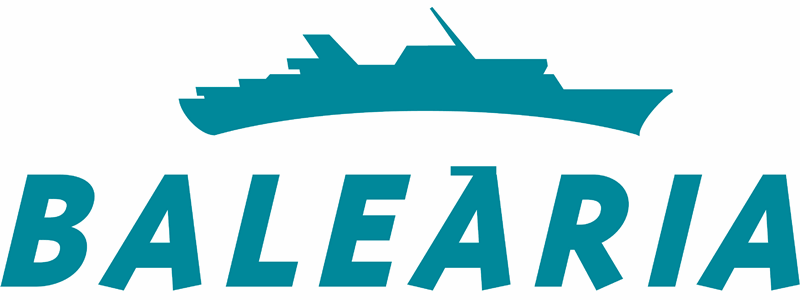
In 2011 was introduced the "Balearia Caribbean" brand operating regularly scheduled cruiseferry service between USA and Bahamas (roundtrips from Fort Lauderdale Florida to Freeport, Grand Bahama Island). In March 2015, the high-speed catamaran Pinar del Rio (1992-built) was replaced by the bigger Bahama Mama (2010-built). The Florida-Bahamas service was terminated in 2017.
In 2016, the company signed a shipbuilding contract (value EUR 320 million) for three LNG-powered smart cruise ferries. The shipbuilder is LaNaval Shipyard (Bilbao, Spain). The first 2 ships will be delivered in 2018, the 3rd one - in 2019. Additional EUR 130 million was allocated for terminal upgrades and fleet refurbishments.
In 2016, Balearia started the services Valencia-Mostaganem (Algeria) and Melilla-Malaga-Almeria. In 2017, Balearia transported 3,7+ million passengers and 5,6 million lane meters of cargo (around 330,000 trucks). The fleet of 25 vessels sailed 1,2+ million ml (around 2 million km). The company has 1500+ employees and reported annual turnover EUR 362 million.
In August 2018 was announced a EUR 60 million (USD 70,2 million) fleet renovation project to convert 5 cruise ferries (by 2020) to run on LNG. The scheduled for drydocks vessels are Abel Matutes, Bahama Mama, Martin i Soler, Napoles, Sicilia. As result, 45,000+ tons of CO2 and 4400 tons of NOx will be reduced annually, plus sulfur and particulates eliminated completely. In August 2018, Balearia acquired Visemar One (for EUR 55 million / USD 62,4 million) expanding the fleet to 26 owned units (out of 30 total).
In late-October 2018, Balearia contracted Caterpillar Marine to install MAK dual-fuel engines on 3 vessels (Abel Matutes, Bahama Mama, Martin I Soler). Engine conversions (by Caterpillar dealer Finanzauto) were scheduled for early-2019. Ship's diesel engines (2x MaK 9M43C) are replaced with 2x MaK 9M46DF (dual-fuel, power output 8,7 MW) used with gearbox and controllable pitch propellers. Caterpillar provided dual-fuel conversion kits and all modules (ignition, ventilation, exhaust gas, and GVU ventilation, valves, housing).
Since August 2019, Baleria Caribbean offers a fast-ferry service from Fort Lauderdale (Florida USA) to Bimini Bahamas, with crossing time ~2 hours. The ship has passenger capacity 650, max speed 38 knots (70 kph / 44 mph) and offers 5 weekly crossings - departures on Mondays, Wednesdays, Fridays, Saturdays and Sundays. Since 2011, Baleria Caribbean also provides daily crossings from Fort Lauderdale to Freeport (Grand Bahama).
TRASMEDITERRANEA
Trasmediterranea (routes, fleet, trasmediterranea.es, 1916-founded, Madrid Spain-headquartered, part of Acciona Group) operates ferries on the routes between mainland Spain and Canaries, Balearics and Morocco (northern Africa).
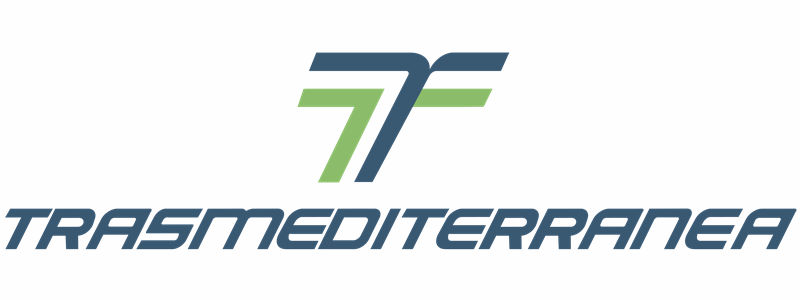
In 1978, the company became a state-owned company, until 2002 when was privatized by the Government. Then the company was acquired by a private consortium (majority shareholder is Acciona Logistica / 60%) and renamed to "Acciona-Trasmediterranea".
Since 1997, Trasmediterranea has its own offices and terminals in Barcelona, Valencia and Las Palmas de Gran Canaria.
In 2000, the superferries Sorolla and Fortuny were deployed on Spain-Balearic routes. Also in 2000 were opened the Spain-Africa routes Almeria-Nador (Morocco) and Almeria- Ghazaouet (Algeria).
In January 2002, Trasmediterranea was awarded a 5-year contract for ferry services to the Balearic Islands, Canary Islands and Spanish Morocco (Ceuta, Melilla).
In 2009 was inaugurated the new Barcelona Ferry Terminal (operated by Trasmediterranea in concession until 2029). In 2011 was inaugurated Trasmediterranea Terminal (Cadiz). In August 2012 was created the Trasmediterranea Cruise division to promote ferry cruises leaving roundtrip from homeport Valencia.
As of 2018, Trasmediterranea owns 24x ferries, 1x high-speed monohull (HSC Almudaina Dos) and 3x vehicle-carrying high-speed catamarans (Alboran, Alcantara Dos, Milenium Dos).
CORSICA-SARDINIA FERRIES
Corsica Sardinia Ferries (routes, fleet, corsica-ferries.fr, 1968-founded, headquartered in Bastia France and Vado Ligure Italy) is a major Western Mediterranean shipping company operating between mainland France-Italy and the islands Elba, Corsica, and Sardinia.
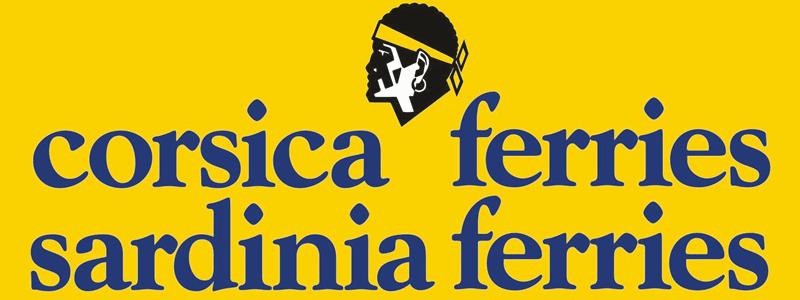
The company's current departure ports are in Italy (Livorno, Savona, Piombino) and France (Toulon, Nice). The company's island ports are on Elba (Portoferraio), Corsica (Bastia, Ajaccio, Porto Vecchio, Ile Rousse, Calvi) and Sardinia (Golfo Aranci, Porto Torres).
Created as "Corsica Line", the company is a merger of two sister brands ("Corsica Ferries" and "Sardinia Ferries") and a subsidiary of Lozali SA (Geneva-based financial holding owned by the Lota family) as a shipowner.
In January 2002 were introduced newly fixed fares for Corsican residents (base rate EUR 5 pp), which was the lowest ever offered on the France-Corsica route. This resulted in traffic boost and increased market share of the company. In 2002 were transported 1,6+ million passengers. In 2005 were transported 2,85+ million passengers to/from Corsica.
In 2015, Corsica Sardinia Ferries transported over 70% of all ferry passengers between Corsica Island and Europe, ranking it far ahead of its main competitors (SNCM, MOBY LINES, La Meridionale) serving this destination.
CORSICA linea
CORSICA LINEA (routes, fleet, corsicalinea.com, 2016-founded, Ajaccio Corsica France-headquartered) operates exclusively on Mediterranean routes connecting mainland France (Marseille) with Corsica France, Sardinia Italy and North Africa (Arab Maghreb - Algeria/Algiers and Tunisia/La Goulette-Tunis).
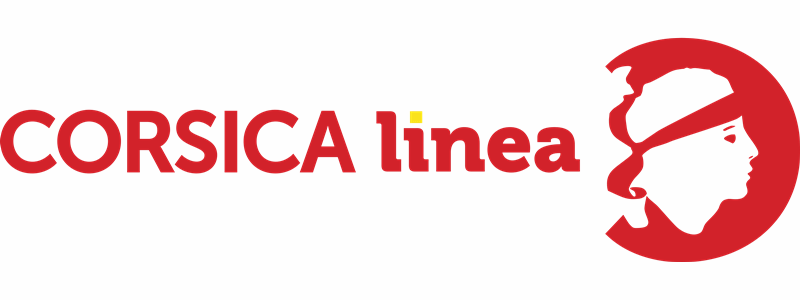
The company brand was created by Corsica Maritima (Corsican consortium) which in 2016 acquired MCM (Maritime Corse Mediterranee - the successor of SNCM-Societe Nationale Maritime Corse-Mediterranee). Corsica linea SAS started operations in January. Following the merger with MCM (sold by Patrick Rocca for shares in Corsica Maritima), on April 11 (2016) the Maritima Ferries brand was abandoned in favor of "Corsica Linea".
The company has ~900 employees (mainly former SNCM staff/crew). For 2016 was reported EUR 170 million turnover and ~0,5 million handled passengers (~300,000 to/from Corsica and ~200,000 to/from Arab Maghreb). For FY2018, the company reported EUR 200+ million in turnover and Europe-Corsica shipping market share ~15% (passengers) and ~60% (freight).
In 2016-2017, SNCM's blue-white livery was replaced fleetwide with company's red-white livery. Since April 2020 is chartered Stena Superfast X (Nepita) for the routes Marseille-Corsica-Northwest Africa.
NAVIERA ARMAS
NAVIERA ARMAS (routes, fleet, navieraarmas.com, 1941-founded, Las Palmas Gran Canaria Spain-headquartered) operates mainly inter-island shipping services in the Canary Islands.
Outbound routes connect the Canaries with Iberia (mainland Spain and Portugal) via North Africa (Morocco).
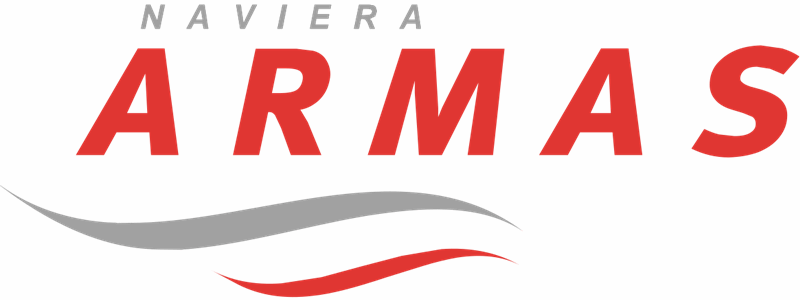
Company's passenger shipping services were introduced in 1995. Its fleet renovation started in 2003 with the newbuild Volcan de Tindaya.
In 2011 were opened new routes between the Canaries and Iberia (mainland Spain-Portugal) - the lines Gran Canaria-Tenerife-Huelva (Spain) and Tenerife-Gran Canaria-Madeira-Portimao (Portugal). In 2012 were opened Canaries-Spain routes via Morocco (Melilla, Nador, Alhucemas).
In October 2017, Naviera Armas purchased from Acciona SA 92,71% of TRASMEDITERRANEA's stocks for EUR 260 million. The company's main rival is the Canaries-based fast-ferry company Fred Olsen Express (1974-founded).
Since 2018 Naviera Armas operates the route connecting to Portimao (Portugal) via Funchal Madeira. This is a seasonal service offered in late-summer only (July through September) via a time-charter deal with Grupo Sousa (Madeira-based company specializing in seaport terminal and ship management, logistics, energy, leisure and tourism services, hotels, restaurants, travel agencies).
The company's newest ship (Volcan de Tagoro, 2019-built) costs EUR 74 million (~USD 82 M) and has capacity 1184 pax + 390 cars.
In mid-April 2021, Grimaldi Group signed an MoU to purchase from Armas Trasmediterranea Group 5x ships (Ciudad de Palma, Ciudad de Granada, Ciudad de Mahon, Volcan del Teide, Volcan de Tijarafe), 2x passenger terminals (Valencia, Barcelona), as well as various warehouses and offices (Valencia, Palma, Mahon, Ibiza).
- The agreement also provided Grimaldi Group with the rights to operate the ARMAS' Spain-Balearic Islands routes with roundtrips from Barcelona and Valencia connecting to Mahon (Menorca), Palma de Mallorca, Ibiza.
- The deal was signed on July 23, 2021, when the new company Trasmed GLE (Valencia-based, Grimaldi-owned) officially acquired the MoU's assets.
- Grimaldi also agreed to rehire Armas' personnel. Mediobanca Group assisted Grimaldi with a loan of EUR 160 million (~USD 188M) for Trasmed GLE.
To the Transmed fleet was also added the 1994-built Euroferry Egnazia (IMO 9010151).
As of 2021, Naviera Armas has a fleet of 11 cruiseferries + 5 HSCs (high-speed craft / catamaran ferries). All Naviera Armas-owned vessels' names start with "Volcan de" and the following name always starts with "T".
MINOAN LINES
Minoan Lines (routes, fleet, minoan.gr, 1972-founded, Heraklion Crete Greece-headquartered, part of Grimaldi Group) operates ferries on the routes between Crete and Piraeus (mainland Greece) and in the Adriatic - between Greece and Italy (Patras to Igoumenitsa-Ancona-Trieste).
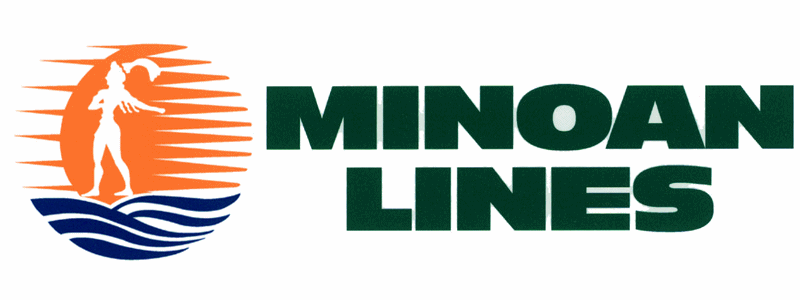
Minoan is one of Europe's largest passenger ferry companies and among the largest in Greece. The company has stakes in Minoan Cruises (80,28%) and owned 33,31% of Hellenic Seaways (sold to Attica Group in 2018). In 2004, Minoan sold its Aegean Airlines stake. Since 2008, Grimaldi Group owns 45% of the Minoan stocks.
In 2012 was closed the ferry route Venice-Igoumenitsa-Patras. In 2013, the existing daily service Patras-Igoumenitsa-Ancona-Patras was extended with Trieste. The new port was connected with 3 departures a week, leaving from both Italy and Greece.
Since January 2017, Minoan's Adriatic line started again to call at Venice (twice weekly). Both arrivals and departures are during the night hours. In 2018 was opened the summer service Greece-Crete (Piraeus-Chania) with Mykonos Palace.
Minoan Lines operates under charter two Grimaldi ships (Cruise Europa, Cruise Olympia), while the Minoan ships Olympia Palace and Europa Palace are currently chartered to TIRRENIA.
HELLENIC SEAWAYS
Hellenic Seaways (hellenicseaways.gr, 2005-founded, Athens Greece-headquartered) operates on shipping routes in Central and Eastern Mediterranean (Adriatic, Aegean). Its parent company is Attica Group.
Hellenic Seaways is the largest Greek ferry company, with a current fleet of 21 vessels (of which 12x high-speed). The company's routes link 35 seaports and connect mainland Greece with the Cyclades, Sporades, northeast-southeast Aegean Sea islands, Crete Island.
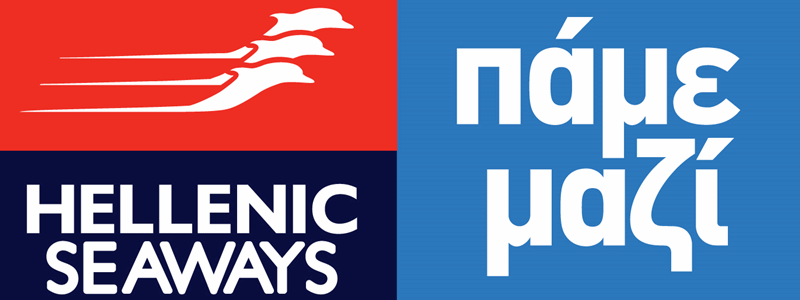
In August 2009, Hellenic Seaways acquired EasyCruise (budget company, 2004-founded) for EUR 9 million. EasyCruise had a fleet of 2 vessels (EasyCruise 1, and EasyCruise Life / Ocean Life) and ceased operations in early 2010. Passengers booked on future cruises received full refunds. Later in 2010, the fleet's only vessel EasyCruise Life was chartered to Blue Ocean Cruises (as Ocean Life). and after ending the charter was scrapped.
In January 2011, Minoan Lines canceled the planned sale of the company's 33,35% stake in Hellenic Seaways to ANEK Lines.
On October 26, 2017, Attica Group signed an agreement for acquiring 48,53% equity stake (37,667,504 shares for EUR 78,5 million) in Hellenic Seaways Maritime (HSW). The ship Superfast XII (now Cruise Ausonia) was purchased separately (from Grimaldi Group for EUR 74,5 million), as well as Highspeed 7 (from Minoan Lines for EUR 25 million). With the 2017 acquisition, Attica Group now holds 98,83% equity stake in HSW.
BLUE STAR FERRIES
Blue Star Ferries (routes, fleet, bluestarferries.com, 1965-founded, Athens Greece-headquartered) is the largest Greek ferry company, part of Attica Group (together with Superfast Ferries).
Blue Star Ferries provide shipping services from mainland Greece to the Greek Islands (Cyclades, Dodecanese, North Aegean, Crete), serving 20+ island destinations.
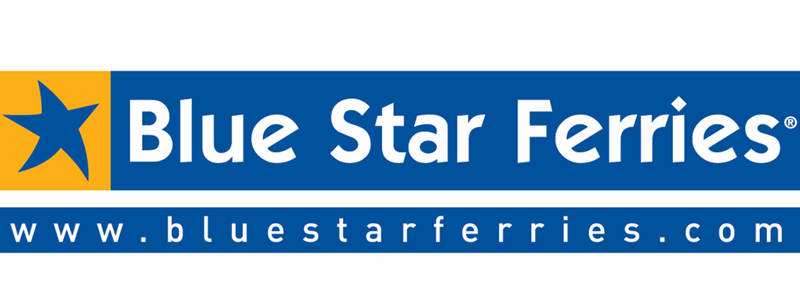
The company (founded as "Strintzis Lines" by the Kefalonia-based Strintzis family) in 2000 was rebranded to "Blue Star Ferries" - following Attica Group's acquisition of a minority share (48% stake) in Blue Star. In 2006, Blue Star Maritime acquired the Dodecanese Islands-based company DANE Sea Lines.
Company's newest/largest ships were built in South Korea (by DSME Daewoo) and delivered in October 2011 (Blue Star Delos) and July 2012 (Blue Star Patmos). In 2019, Blue Star Ferries acquired from HELLENIC SEAWAYS two sisterships (Blue Star Chios, Blue Star Mykonos).
The parent company Attica Group is a European holding which main ferry operations started in 1995 with the subsidiary Superfast Ferries. The company also has a minority share in Blue Star Ferries which operates in Aegean Sea (Greek islands).
ANEK LINES
ANEK Lines (routes, fleet, anek.gr, 1967-founded, Chania Crete Greece-headquartered) is Greece's largest passenger shipping company operating on Aegean and Adriatic routes.
The company is Athens Stock Exchange-listed, with the biggest shareholder the Greek family Vardinoyannis via its companies Sea Star Capital (37,5%) and Varmin Marble (26,9%).
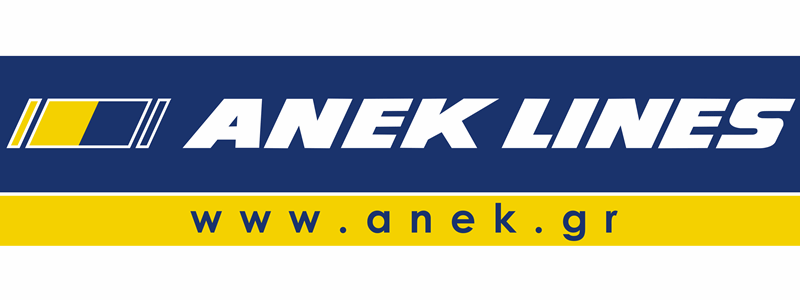
Shipping operations started in 1970 on the route Piraeus-Chania. In 1973 was started the Piraeus-Heraklion line. In 1989 started the Patras-Corfu-Igoumenitsa-Ancona and the Patras-Trieste lines. In 1999, the company was listed on the Athens Stock Exchange. ANEK also acquired Rethymniaki Naftiliaki SA (with 2 ships) starting the Piraeus-Rethymno service. ANEK bought 16,5% of NEL Lines.
In 2000, ANEK bought 50% of ETANAP SA, also 62% of Lefka Ori Ltd. Also in 2000 was signed the shipbuilding contract with Fosen Shipyard for two newbuild vessels, with scheduled deliveries in October 2000 (Olympic Champion) and May 2001 (Hellenic Spirit), plus optional two more units. The new ferries were deployed on the route Patras-Igoumenitsa-Ancona (crossing time 15 hours).
In 2002 started the Piraeus-Heraklion (Crete) line. In 2003 was inaugurated ANEK CARGO (ro-ro freight service) on the Piraeus-Heraklion, Patras-Bari, and Patras-Venice routes. In 2008 started the Greek Islands services Piraeus-Paros-Naxos-Ios-Santorini, Piraeus-Chios-Lesbos and also Piraeus-Chania. In 2010 were started charter-ship operations on the island route Piraeus-Syros-Mykonos-Ikaria-Fourni-Samos.
"ANEK Superfast" (2011-founded) is a joint venture with Superfast Ferries (Attica Group) for the routes Patras-Igoumenitsa-Ancona and Piraeus-Heraklion. In 2014 started the year-round service Bari-Durres (Albania).
SUPERFAST FERRIES
Superfast Ferries (routes, fleet, superfast.com, 1993-founded, Athens Greece-headquartered, part of Attica Group /together with Blue Star Ferries) provides fast-ferry links between Greece and Italy.
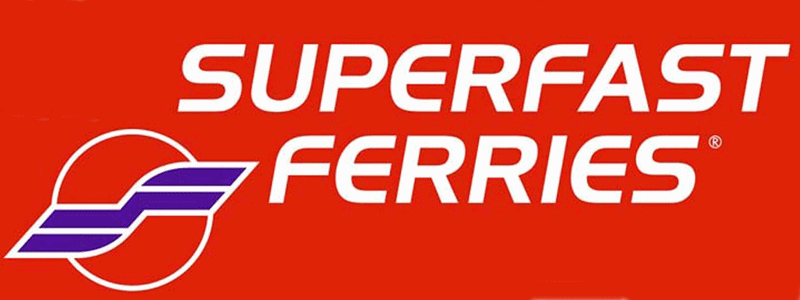
Currently, Superfast Ferries operates only in the Eastern Mediterranean (Aegean and Adriatic), on the routes between Greece and Italy. These routes are with departures from homeports Ancona-Bari and Igoumenitsa-Patras-Corfu. In the period 2002-2008 (September), the company also served the North Sea route Rosyth (Scotland)-Zeebrugge (Belgium)
In April 2006, Attica Group sold its ice-class ships Superfast 7, Superfast 8 and Superfast 9 to TALLINK-SILJA. The deal was for EUR 310 million.
In August 2006 Attica Group sold its ice-class ship Superfast 10 to Veolia Transport (French-based multinational company) for EUR 112 million. The vessel was delivered to the new owner in January 2007.
On June 8, 2011, Superfast Ferries and ANEK Lines created a joint venture service of the routes Piraeus-Heraklion (Crete) and Patras-Igoumenitsa-Ancona. Until 2013, the company also served the route Piraeus (Athens)-Heraklion (Crete) with Superfast VI. As the ship was sold to Genting Group (Asia) in March 2013, this service was discontinued.
SEAJETS FERRIES
Seajets Ferries (routes, fleet, seajets.gr, 1989-founded, Athens Greece-headquartered) operates mainly HSCs (high-speed craft/catamarans) that transport passengers and vehicles in the Aegean Sea (Eastern Mediterranean), serving Greece's Cyclades Islands (including Crete).
The company currently offers 260 interisland itineraries connecting 26 Greek islands.
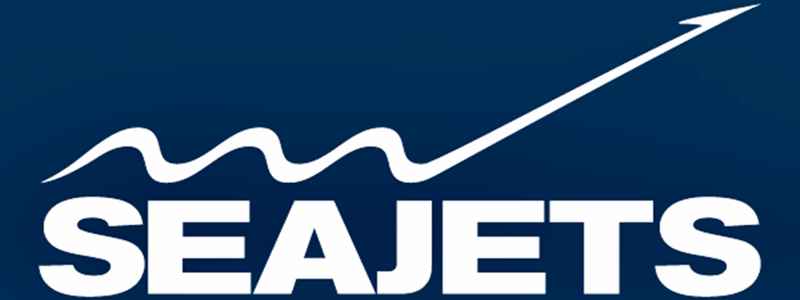
Seajets' current fleet consists of 14x HSCs plus 3 standard Ro-Pax ships (Aqua Blue, Aqua Jewel, Alexandra L).
In 2020, Seajets Greece purchased 6 cruise liners (Aegean Majesty, Aegean Myth, Aegean Goddess, Queen of the Oceans, CMV Columbus, CMV Magellan).
The largest catamaran (HSC Tera Jet/IMO 9179660, 1999-built) has length 145 m, GT 11350 tons and max capacity 2100 passengers plus 600 cars.
The largest ferry (Aqua Blue/IMO 7429669, 1975-built) has max capacity 1300 passengers plus 400 cars.
The largest cruise ship (Queen of the Oceans/fka Ocean Princess, 2000-built) has max passenger capacity 2416.
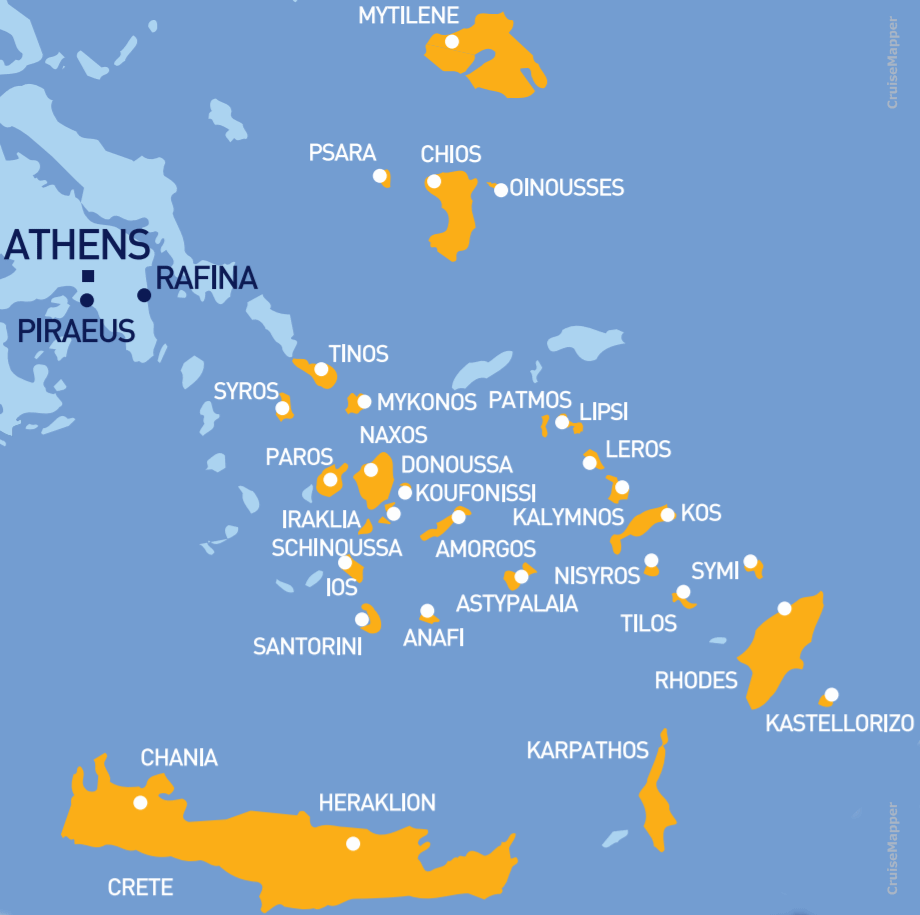
The above map shows all Greek island ports served by ferries leaving from mainland Greece (Piraeus and Rafina).
MOL FERRIES Japan
MOL Ferries (routes/fleet, sunflower.co.jp) was established in 2023 by merging two Mitsui OSK Lines/MOL Group-owned ferry companies - Ferry Sunflower Ltd (2009-founded, Oita City-headquartered) and MOL Ferry Co Ltd (1969-founded as Nippon Enkai Ferry, Tokyo-headquartered).
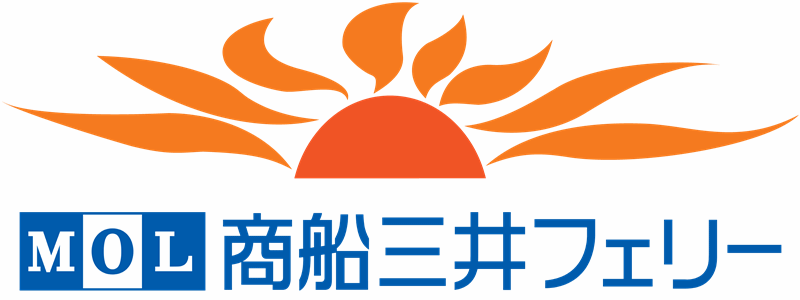
The merger created Japan's largest cargo, vehicle and passenger shipping company, regularly serving 6 major routes with a fleet of 15 vessels. MOL started ferry operations in 1912 (Hanshin-Beppu route).
Next are listed the company's major changes in the last decade.
In March 2014 was completed Shibushi Ferry Terminal's renovation.
In September 2017 were acquired (for 10 years/thru 2027) the naming rights for Osaka Nanko Cosmo Ferry Terminal - now named "Sunflower Terminal Osaka".
In 2017 were inaugurated the ships Sunflower Furano (May) and Sunflower Sapporo (October).
In 2018 were inaugurated the ships Sunflower Satsuma (May) and Sunflower Kirishima (September).
In October 2019 was completed Osaka Nanko Terminal's renovation.
In 2023 were inaugurated the ships Sunflower Kurenai (January) and Sunflower Murasaki (April). Two more same-designed units are planned for 2025. In October was established MOL's brand Mitsui Ocean Cruises.
Norwegian ferry companies
The list of major ferry companies serving Norway includes COLOR LINE, FJORD LINE, Fjord1 Line, Havila Voyages, Hurtigruten.
FJORD LINE
FJORD LINE (1993-founded, Bergen Norway-headquartered) connects with RoPax ships Norway with Denmark and Sweden, plus Norway-Denmark freight service.
The company acquired In 1998 from COLOR LINE the ship Jupiter and started the Norway-UK service (Bergen-Newcastle upon Tyne). In 2004 was purchased MS Fjord Norway for the Norway-Denmark service. in 2005 MS Fjord Norway and the Norway-England route were sold to DFDS.
In January 2008, Fjord Line merged with Master Ferries. In 2014 Fjord Line became the industry's first to use RFID cards as cabin keys. Since January 2014, the Norwegian authorities allow Fjord Line ships to be LNG-bunkered (fueled) whilst passengers are still on board.
Currently, FJORD LINE serves the routes Bergen-Stavanger-Hirtshals, Kristiansand-Hirtshals (summer only), Hirtshals-Langesund and Sandefjord-Stromstad. The current fleet includes HSC Fjord Cat (1998-built catamaran, one of the world's fastest Ro-Pax vessels), Stavangerfjord (2013), Bergensfjord (2014), Oslofjord (1993-built as "Bergensfjord", renamed in 2014).
FJORD1 LINE
Fjord1 Fylkesbaatane (1858-founded, Floro Norway-headquartered) is a subsidiary of Fjord1 Nordvestlandske (Norwegian transport conglomerate) and runs ferry traffic in Sogn og Fjordane (western Norway).
Fjord1's route Bergen-Sogn was opened in 1971 via fast catamarans. Currently are served the routes Bergen-Sogn (Ovre Ardal, crossing time 6 hr 15 min) and Bergen-Nordfjord (Selje, crossing time 5 hours). In addition to these main services are also served local fast boat routes.
The company is among the first in Norway to use LNG-powered ferries. Most Fjord1 ships are older ferries (built between 1960-1980) and mainly car carriers. Fjord1's current fleet includes the car-passenger and passenger-only ships Fjordglytt, Sylvarnes, Gudvangen, Skagastol.
SMALL-FLEET ferry companies
Next are listed several small-fleet companies which serve predominantly their respective domestic markets.
CONDOR FERRIES
In March 2020, the company was purchased by a joint venture between Brittany Ferries (minority shareholder) and Columbia Threadneedle ESIF. Its previous owner (100%) was MIRA (Macquarie Infrastructure and Real Assets, part of Macquarie Group Ltd).
CONDOR FERRIES (condorferries.co.uk, 1964-founded, St Peter Port Guernsey-headquartered) offers passenger and freight ferry services between UK-France and the Channel Islands - Jersey (St Helier Port) and Guernsey (St Peter Port).
Condor Ferries' current fleet includes the high-speed catamarans Condor Rapide and Condor Liberation and the ships Commodore Clipper and Commodore Goodwill on the routes Poole England-Channel Islands, Portsmouth England-Channel Islands, St Malo France-Channel Islands, and the inter-island service Guernsey-Jersey.
Annually, Condor Ferries serves ~1 million passengers, ~55000 freight units (~0,9 million cargo lanemeters) and ~200,000 passenger vehicles.
DESTINATION GOTLAND
DESTINATION GOTLAND (destinationgotland.se, 1998-founded, Visby Gotland Sweden-headquartered, subsidiary of Rederi Gotland AB/aka Gotlandsbolaget) is a domestic ferry company operating in Sweden exclusively. Destination Gotland's current fleet includes the conventional ferries MS Gotland (ex Thjelvar), MS Visborg, MS Visby, MS Drotten (ex Gotland), the high-speed HSC Gotlandia and HSC Gotlandia 2, as well as the 2004-built cruiser Birka Gotland.
The company's two shipbuilding contracts (signed November 2014 and June 2015) with GSI (Guangzhou Shipyard, China) resulted in the LNG-powered ships Visborg (2018) and Gotland (2019). Each vessel has a capacity of 1650 passengers and costs USD 150 million. Birka Stockholm was acquired in 2023 for EUR 38M.
Before the newbuilds, Destination Gotland had the fleet capacity to serve daily up to 23920 passengers. In 2017, the company ferried 1,749755 million passengers (+7,8% over 2016).
In 2024, from DFDS was acquired the Norway-Denmark route Copenhagen-Oslo (crossing time 17 hours) for ~US$57,6 million.
POLFERRIES
POLFERRIES (fleet, polferries.pl, 1976-founded) is Poland's largest ferry shipping company. "Polish Baltic Shipping Company" was established as a state-owned company. Under the brand name "Polferries" it runs Baltic Sea services connecting Poland to Sweden.
POLFERRIES has 2 new ships on order, to be built at Szczecin Shipyard.
NORTHLINK FERRIES (Scotland)
Serco NORTHLINK FERRIES (fleet, northlinkferries.co.uk, 2002-founded, Stromness Orkney Scotland-headquartered) operates lines between Shetland and mainland Scotland on the routes Aberdeen-(Kirkwall)-Lerwick and Stromness-Scrabster.
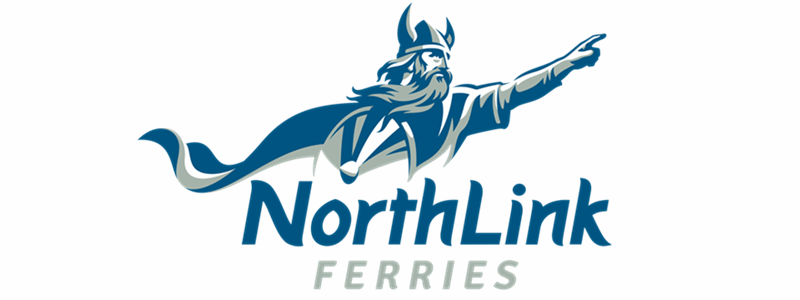
MARINE ATLANTIC
MARINE ATLANTIC (fleet, marineatlantic.ca, 1986-founded, St John's NF Canada-headquartered) is a federal/state-owned corporation operating ferries between the provinces Nova Scotia and Newfoundland Island.
ECKERO LINE
ECKERO LINE (eckeroline.fi, 1995-founded, Helsinki Finland-headquartered) operates just one boat (MS Finlandia, 2080 pax, 665 cars) and only on the route between Finland-Estonia (Helsinki-Tallinn).
TT-LINE Tasmania
TT-Line Tasmania (officially "TT-Line Company Pty Ltd", SpiritOfTasmania.com.au, 1985-founded, headquarters Devonport Tasmania and Melbourne Australia) specializes in passenger shipping between Victoria Australia and Tasmania (Bass Strait crossings). Since 1993, TT-LINE is a Tasmanian Government fully-owned company.
On December 8, 2017, TT-LINE announced that the existing ferries (Tasmania 1 and Tasmania 2) will be replaced with two newbuilds.
In January 2018 was selected Flensburger Schiffbau-Gesellschaft (Flensburg, Germany) as a shipbuilder. In May 2018, TT-LINE signed EUR 438 million shipbuilding order for 2x LNG-powered cruiseferries. In February 2020, TT-LINE signed with the shipbuilder RMC-Rauma Marine Constructions Oy (Finland) an MoU for 2x newbuilds.
- Due to the COVID crisis, in mid-July 2020 the MoU was withdrawn. Negotiations with RMC resumed in March 2021, initiated by Tasmania's state government.
- Construction works on the boats started in 2022, with deliveries in 2024-Q3 ((Tasmania IV) and 2024-Q4 (Tasmania V). Both ferries were intended for the Australia-Tasmania route Geelong-Devonport.
By design, each ship has volume 48000 GT-tons, LOA length 212 m, 301 cabins, passenger capacity 1800, freight capacity 600 cars. The new ferries increased the company's capacity by 43% (passengers) and 39% (freight).
WASALINE
WASALINE (wasaline.com) is the successor of Vaasa-Umea AB (1948-founded/1993-defunct Finnish shipping company) that ceased operations (under the "Wasa Line" brand) in 1993 following the merger into Silja Line. The new WASALINE (2013-founded) is a subsidiary and travel brand owned by Kvarken Link Oy (2019-founded, subsidiary of Kvarken Link AB/joint venture with Kvarken Ports).
Wasaline's Vaasa Finland-Umea Sweden service was inaugurated on January 3, 2013, with the ship Wasa Express (1981-built). In 2021, Wasa Express was replaced by the newbuild Aurora Botnia.
HOLLAND NORWAY LINES
Holland Norway Lines BV (hollandnorwaylines.com) is a startup (2020-founded) company operational since April 2022. The new brand operates the route Eemshaven-Kristiansand (crossing time ~18 hours) via the chartered Tallink Romantika (maiden voyage on April 7th/3-year bareboat charter, with 2x 1-year extensions). Tickets are priced at EUR 200 pp.
This is a work in progress, so expect more lines and ships next time you visit. Enjoy CruiseMapper's new "FerryMapper" feature and be sure to bookmark this page for updates and latest news!
Itinerary of Ferries
Here are listed all CruiseMapper's ferry lines with their cruise ferry fleets, homeports (routes) and crossing times. Our list of ferries currently includes passenger vessels operated by the world's largest ferry companies:
- VIKING LINE, STENA LINE, TALLINK-SILJA LINE, FINNLINES, TT LINE
- DFDS SEAWAYS, P&O FERRIES, BRITTANY FERRIES, IRISH FERRIES
- COLOR LINE, BALEARIA, MOBY LINES, GRIMALDI LINES
- GNV (Grandi Navi Veloci), TIRRENIA, SNCM (Maritima Ferries)
- TRASMEDITERRANEA, CORSICA-SARDINIA FERRIES, CORSICA linea, NAVIERA ARMAS
- MINOAN LINES, HELLENIC SEAWAYS, BLUE STAR FERRIES, SUPERFAST FERRIES, SEAJETS FERRIES
- ANEK LINES, NEL Lines
- BC FERRIES
- MOL FERRIES Japan
- plus small-fleet companies (DESTINATION GOTLAND, CONDOR FERRIES, POLFERRIES, MARINE ATLANTIC, ECKERO LINE, WASALINE).
VIKING LINE
Currently, VIKING LINE ships operate on the following ferry routes:

- Aland-Sweden / Mariehamn-Kapellskar (crossing time 2,5 hours)
- Finland-Sweden / Helsinki-Mariehamn Aland-Stockholm (17 hours)
- Finland-Sweden / Turku-Mariehamn Aland-Stockholm, 10 hours
- Stockholm-Mariehamn (5,5 hours) and Sweden-Latvia (Stockholm-Riga / 17 hours, during summer)
- Finland-Estonia / Helsinki-Tallinn (2,5 hours)
STENA LINE
Currently, STENA LINE ships operate on the following passenger ferry routes:

- (Ireland-Wales UK, crossing time 3,5 hours) Rosslare-Fishguard (Irish Sea)
- (Ireland-Wales UK, 3 hours) Dublin-Holyhead (Irish Sea)
- (Northern Ireland-Scotland UK, 2 hours 15 min) Belfast-Cairnryan (Irish Sea)
- (Northern Ireland-England UK) Belfast-Heysham (the Irish Sea, freight only)
- (Northern Ireland-England UK, 8 hours) Belfast-Liverpool/Birkenhead (Irish Sea)
- (Ireland-France, 17 hours) Rosslare-Cherbourg
- (Holland-England UK, 6,5 hours) the Hook of Holland-Harwich (North Sea)
- (Holland-England UK) the Hook of Holland-North Killingholme Haven (North Sea, freight only)
- (Holland-England UK) Rotterdam-Harwich (the North Sea, freight only)
- (Holland-England UK) Rotterdam-North Killingholme Haven (the North Sea, freight only)
- (Sweden-Denmark, 3 hours) Goteborg-Frederikshavn (Baltic Sea)
- (Sweden-Denmark, 5 hours) Varberg-Grena (Baltic Sea)
- (Sweden-Germany, 9 hours) Goteborg-Kiel (Baltic Sea)
- (Norway-Denmark, 9 hours) Oslo-Frederikshavn (Baltic Sea)
- (Sweden-Poland, 10 hours) Karlskrona-Gdynia (Baltic Sea)
- (Sweden-Latvia, 8,5 hours) Nynashamn-Ventspils (Baltic Sea)
- (Sweden-Germany, 6 hours) Trelleborg-Rostock (Baltic Sea)
- (Germany-Latvia) Travemunde (Lubeck)-Liepaja (Baltic Sea)
TT LINE

Currently, TT LINE ferries operate on the routes:
- (Sweden-Germany) Trelleborg-Rostock and Trelleborg-Travemunde (daily departures, crossing times 6-6,5 hours)
- (Sweden-Germany) Helsingborg-Travemunde (freight-only)
- (Sweden-Poland) Trelleborg-Swinoujscie (6 hours), and (Denmark-Poland) Ronne-Swinoujscie (5 hours)
DFDS SEAWAYS
Currently, DFDS SEAWAYS ships operate on the following passenger ferry routes:

- (English Channel /2 hours) UK England-France (Dover-Dunkirk)
- (English Channel /2 hours) UK England-France (Dover-Calais)
- (English Channel /24 hours) Ireland-France (Rosslare-Dunkirk)
- Short break "Mini Cruise" UK England-Holland /15,5 hours (Newcastle-IJmuiden / Amsterdam)
- UK England-France (Newhaven-Dieppe)
- Lithuania-Germany (Klaipeda-Kiel) 19,5 hours
- Lithuania-Sweden (Klaipeda-Karlshamn) 13 hours
- Estonia-Sweden (Paldiski-Kapellskar)
- Estonia-Finland (Paldiski-Hanko)
- Mediterranean France-Tunisia (Marseille-Tunis)
BRITTANY FERRIES
Currently, BRITTANY FERRIES ships operate on the following routes:

- Roscoff-Cork Ireland-Roscoff (crossing time 14 hours)
- Cherbourg-Portsmouth England-Cherbourg (3 hours)
- Roscoff-Plymouth-Roscoff (6 hours)
- Portsmouth-Roscoff-Bilbao-Portsmouth (24-36 hours)
- Portsmouth-Le Havre Paris (5,5 hours)
- Plymouth-Santander Spain-Plymouth (20 hours)
- Portsmouth-Santander-Portsmouth (24 hours)
- Cherbourg-Poole England-Cherbourg (4 hours)
- Saint Malo-Portsmouth-Saint Malo (11 overnights, 8 days)
- Caen-Portsmouth-Caen (6 hours)
- Portsmouth-Le Havre (5,5 days / 8 overnights)
- Cork-Roscoff (1 weekly return-crossing)
- Rosslare-Cherbourg-Bilbao
- Bilbao-Poole UK-Bilbao (freight-only)
BC FERRIES
BC FERRIES' largest ships operate on the following routes (daily service):

- Vancouver Island (between Tsawwassen and Swartz Bay / Victoria BC) - crossing time 1,5 hours, distance 45 km (28 mi)
- Vancouver Island (between Tsawwassen and Duke Point / Nanaimo BC) - 2 hours, distance 70 km (44 mi)
- Horseshoe Bay-Tsawwassen / between West Vancouver (Metro) and Vancouver Island) - 1 hour 40 min, distance 56 km (35 mi)
- Prince Rupert-Port Hardy / Kaien Island-Vancouver Island) - "Day Cruise" Inside Passage (overnight), distance 507 km (315 mi) - Port Hardy, Bella Bella (Campbell Island), Klemtu (Swindle Island), Prince Rupert.
- Prince Rupert-Skidegate Graham Island / Haida Gwaii, crossing time 7 hours, distance 172 km (107 mi)
The company connects mainland British Columbia with the Gulf Islands Cortes, Denman, Hornby, Quadra, Sointula, Texada, Bowen, Gabriola, Galiano, Mayne, Pender, Salt Spring, Saturna, Thetis. The list of destinations also includes Cariboo Chilcotin Coast, Sunshine Coast, Coast Mountains, Vancouver Metro, Northern BC, Thompson Okanagan, Victoria Harbour, and Vancouver Island.
PandO FERRIES
Currently, P&O FERRIES ships operate on the following routes:

- UK to France (Dover-Calais)
- mini cruises England UK to Holland (Hull-Rotterdam) - crossing time 10 hours
- England to Ireland (Liverpool-Dublin)
- Scotland UK to Northern Ireland (Cairnryan-Larne)
- freight ferry service UK-Belgium (London Tilbury-Zeebrugge)
TALLINK-SILJA LINE
Currently, TALLINK-SILJA LINE ships operate on the following cruise ferry routes:

- Finland-Sweden (Helsinki-Aland (Mariehamn)-Stockholm (crossing time 16 hours)
- Finland-Sweden (Turku-Aland (Mariehamn or Langnas)-Stockholm (10,5 hours)
- Estonia-Sweden (Tallinn-Mariehamn Aland-Stockholm (15,5 hours)
- Sweden-Latvia (Stockholm-Riga (17 hours)
- Finland-Estonia (Helsinki-Tallinn (2 hours)
FINNLINES
Currently, FINNLINES ships operate on the following passenger ferry routes:

- Finland-Germany (Helsinki-Travemunde) crossing time 27-29 hours
- Finland-Sweden (Naantali-Kapellskar via Langnas Aland) 8-9 hours
- Sweden-Germany (Malmo-Travemunde) 9 hours
Freight-only services are offered on the routes Finland-Poland (Helsinki-Gdynia, with 3-4 weekly departures) and Finland-Denmark (Helsinki-Aarhus, with 2 weekly departures).
COLOR LINE
Currently, COLOR LINE ships operate on the following passenger ferry routes:

- (Norway-Germany / Oslo-Kiel) crossing time 20 hours
- (Norway-Sweden / Sandefjord-Stromstad) 2,5 hours
- (Norway-Denmark / Kristiansand-Hirtshals) 3 hours 15 min
- (Norway-Denmark / Larvik-Hirtshals) 3 hours 45 min
MOBY LINES
Currently, MOBY LINES ships operate on the following ferry routes:

- Santa Teresa di Gallura-Bonifacio Corsica
- Piombino-Cavo Elba Island
- Piombino-Portoferraio Elba (crossing time 1 hour)
- Livorno-Bastia Corsica (4,5 hours)
- Livorno-Olbia Sardinia / Olbia-Genoa (6-6,5 / 10,5 hours)
- Genoa-Olbia Sardinia (10,5 hours)
- Civitavecchia Rome-Olbia Sardinia (5,5-6,5-8 hours / day and night crossings)
- Livorno-Olbia / Piombino-Olbia (5-6 hours)
- Livorno-Olbia Sardinia (6 hours)
- Genoa-Bastia Corsica (5 hours)
- Nice France-Bastia Corsica (5 hours)
- St Petersburg Russia-Helsinki Finland-Stockholm Sweden-Tallinn Estonia (62,5 hours)
GRIMALDI LINES
Currently, GRIMALDI LINE ships operate on the following routes:

- Italy-Spain - Civitavecchia-Porto Torres (Sardinia)-Barcelona / crossing time 20 hours)
- Italy-Spain (Savona-Barcelona / 17 hours)
- Italy-Morocco - Savona-(Barcelona)-Tangier / 32 hours
- Italy-Tunisia via Sicily - Civitavecchia-Palermo-Tunis (18,5 hours), Salerno-Palermo-Tunis (16,5 hours) - including freight-only
- Sardinia-Italy (Porto Torres-Civitavecchia / 7 hours 15 min)
- Sardinia-Spain (Porto Torres-Barcelona / 11 hours 45 min)
- Sardinia-Italy (Olbia-Livorno / 8 hours 15 min)
- Sardinia-Italy (Olbia-Civitavecchia / 6,5 hours)
- Italy-Sicily (Livorno-Palermo / 18 hours)
- Italy-Greece (Brindisi-Corfu Island-Igoumenitsa / 30,5 hours) and Venice-Ancona-Igoumenitsa-Patras (36 hours)
- Greece-Crete (Piraeus-Chania / ~9 hours) during summer
GNV (Grandi Navi Veloci)
Currently, GNV ships operate on the following routes:

- Genoa-Palermo Sicily (crossing time 21 hours)
- Genoa-Tunis (Italy-Tunisia /24 hours)
- Genoa-(Barcelona)-Tangier (Italy-Morocco /49,5 hours)
- Genoa-Porto Torres Sardinia (12 hours)
- Genoa-Olbia Sardinia (12 hours)
- Naples-Palermo Sicily (11-13 hours)
- Civitavecchia-Palermo-Tunis (Italy-Tunisia /25 hours)
- Spain-Balearic Islands routes Valencia-Mallorca-Ibiza (crossing times 5-7 hours to Ibiza, 7-10 hours to Mallorca)
- Barcelona-Tangier (Spain-Morocco /32 hours)
- Sete-(Barcelona)-Tangier (France-Morocco /40 hours)
TIRRENIA Navigazione
Currently, TIRRENIA ships operate on the following routes:

- mainland Italy to Sardinia Island - Genoa-Porto Torres (Nuraghes, Sharden), Genoa-Olbia-Arbatax (Athara, Bithia, Janas), Civitavecchia-Olbia-Arbatax (Athara, Bithia, Janas), Civitavecchia-Cagliari (Athara, Bithia, Janas), Naples-Cagliari, Livorno-Cagliari (freight-only)
- mainland Italy to Sicily Island - Naples-Palermo, Ravenna-Brindisi-Catania (freight-only)
- Sardinia to Sicily - Cagliari-Palermo
- mainland Italy (Termoli) to Tremiti Islands
- mainland Italy to Tunisia - Genoa-Tunis
- Sicily to Malta - Catania-Valletta
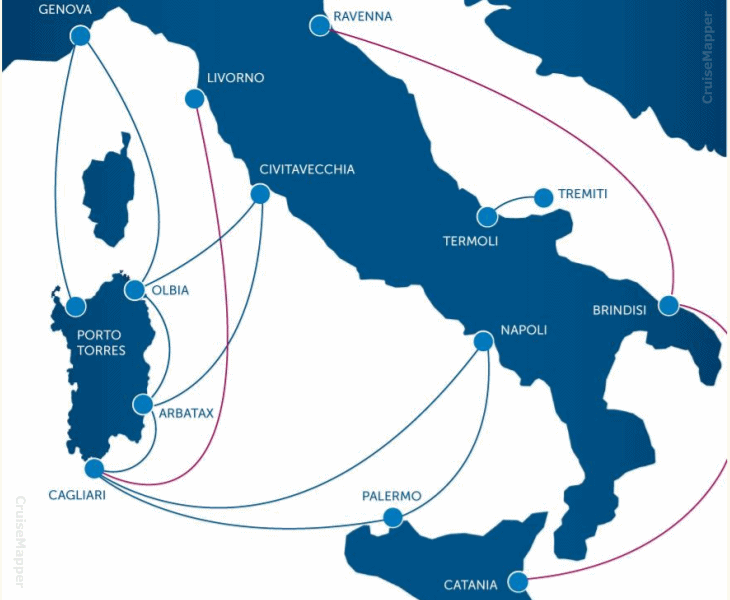
IRISH FERRIES
Currently, IRISH FERRIES ships operate on the following routes:

- (Ireland-Wales UK) Dublin-Holyhead (crossing time 2 hours)
- (England-France) Dover-Calais (English Channel /2 hours)
- (Ireland-Wales UK) Rosslare-Pembroke (4 hours)
- (Ireland-France) Dublin-Cherbourg, on weekends /19 hours
- (Ireland-Wales UK) Dublin-Holyhead, workweek /2 hours
BALEARIA
Currently, BALEARIA ships operate on the following ferry routes:

- Algeciras to Ceuta and Tangier
- Almeria to Melilla and Nador
- Barcelona to Ibiza, Mallorca, Menorca
- Ceuta to Algeciras
- Denia to Ibiza, Mallorca, Formentera
- Formentera to Ibiza and Denia
- Ibiza to Barcelona, Denia, Mallorca, Formentera, Valencia
- Malaga to Melilla
- Mallorca to Barcelona, Ibiza, Menorca, Denia, and Valencia
- Melilla to Almeria and Malaga
- Menorca to Barcelona and Mallorca
- Valencia to Mallorca, Ibiza, Mostaganem
USA Florida to Bahamas (Fort Lauderdale to Freeport Grand Bahama and to Bimini Island) is Balearia's high-speed Bahamas Ferry Service, with crossing times 2,5-3 hours.
TRASMEDITERRANEA
Currently, TRASMEDITERRANEA ships operate on the following routes:

- (roundtrip from Barcelona to) Ibiza, Mahon (Menorca), Palma de Mallorca, Formentera
- (roundtrip from Palma de Mallorca to) Ibiza, Mahon (Menorca)
- (roundtrip from Valencia to) Ibiza, Mahon (via Palma), Formentera
- roundtrip from Cadiz to Arrecife
- Cadiz-Las Palmas (via Arrecife), Cadiz- Tenerife (via Las Palmas), Cadiz-La Palma (via Arrecife, Las Palmas, Tenerife), Cadiz-Fuerteventura (via Arrecife, Las Palmas, Tenerife, La Palma)
- (from Lanzarote Island) Arrecife-Las Palmas, Arrecife-Tenerife (via Las Palmas), Arrecife-La Palma (via Las Palmas, Tenerife), Arrecife-Fuerteventura (via Las Palmas, Tenerife, La Palma)
- (from Gran Canaria Island) Las Palmas-Tenerife, Las Palmas-La Palma (via Tenerife), Las Palmas-Fuerteventura, Las Palmas-Arrecife (via Tenerife, Fuerteventura), Las Palmas-Cadiz (via Fuerteventura, Arrecife)
- (from Tenerife Island) Santa Cruz de Tenerife-Las Palmas, Tenerife-Fuerteventura (via Las Palmas), Tenerife-Arrecife (via Las Palmas, Fuerteventura), Tenerife-Cadiz (via Gran Canaria , Fuerteventura, Lanzarote)
- (from San Miguel de La Palma Island) Santa Cruz de la Palma-Las Palmas (via Tenerife), La Palma-Puerto Rosario-Fuerteventura (via Tenerife, Las Palmas), La Palma-Arrecife (via Tenerife, Las Palmas, Puerto Rosario, Fuerteventura), La Palma-Cadiz (via Tenerife, Las Palmas, Fuerteventura, Arrecife)
- (from Fuerteventura Island) Puerto del Rosario-Arrecife, Fuerteventura-Cadiz (via Arrecife)
- Algeciras-Ceuta (Spanish Morocco), Algeciras-Tangier (Morocco)
- Almeria-Melilla (Spanish Morocco), Almeria-Ghazaouet (Algeria), Almeria-Nador (Morocco), Almeria-Oran (Algeria)
- Malaga-Melilla
CORSICA-SARDINIA FERRIES
Currently, CORSICA-SARDINIA FERRIES ships operate on the following routes:

Between mainland France-Italy and Corsica Island (In brackets are crossing times)
- between Nice and Ajaccio (6 hours), Bastia (5 hours), Calvi (4 hours), Ile Rousse (4 hours), Porto Vecchio (9 hours)
- between Toulon and Ajaccio (6,5 hours), Bastia (8,5 hours), Ile Rousse (6 hours 15 min), Porto Vecchio (12 hours)
- between Savona and Bastia (4,5 hours), Calvi (6 hours)
- Livorno-Bastia (3,5 hours)
- Piombino-Bastia (2 hours 15 min)
Between mainland Italy-France and Sardinia Island
- Livorno-Golfo Aranci (6,5 hours)
- Toulon-Porto Torres (13 hours)
- Nice-Golfo Aranci (16 hours)
Elba Island (Portoferraio) to/from Piombino (30 min) and Bastia (90 min).
CORSICA LINEA
CORSICA LINEA operates on the Mediterranean Sea routes only, connecting mainland France (Marseille) with Corsica Island (France), Sardinia Island (Italy) and North Africa (Arab Maghreb) - Algeria and Tunisia.

Corsica Linea ferry links include:
- Marseille-Corsica (Ajaccio)
- Marseille-Corsica (Bastia)
- Marseille-Algeria (Algiers) / including seasonal-only crossings
- Marseille-Tunis / including seasonal-only crossings
- Marseille-Algeria (Bejaia) / seasonal-only crossings
- Marseille-Ile Rousse - Monte d'Oro
- Corsica-Sardinia (Ajaccio-Porto Torres)
NAVIERA ARMAS
NAVIERA ARMAS operates mainly inter-island shipping services in the Canary Islands, also connecting the Canaries with Iberia (mainland Spain and Portugal) and North Africa (Morocco).

- Las Palmas (Gran Canaria) - Morro Jable (Fuerteventura) / crossing time 5 hours
- Las Palmas - Santa Cruz de Tenerife /2 hours
- Santa Cruz de Tenerife - Morro Jable (Fuerteventura) Las Palmas /2,5 hours
- Los Christianos (Tenerife)-San Sebastian (La Gomera)
- Motril (Granada)-Nador (Morocco) /6 hours
- Motril - Melilla (Spanish Morocco) /6 hours
- Huelva (Spain)-Tenerife -Gran Canaria /36-37 hours
MINOAN LINES
Currently, MINOAN LINES ships operate on the following routes:

- (Greece-Crete) Piraeus-Heraklion / crossing time 6 hours
- (Greece-Italy) Patras-Igoumenitsa-Ancona-Trieste / 29,5 hours (22 hours to Ancona)
BLUE STAR FERRIES
Currently, BLUE STAR FERRIES ships operate on the following routes:

Note: All departures to the Greek Islands are roundtrips from Port Piraeus (Athens).
- (Greece to Crete) Piraeus-Heraklion
- (Greece to Crete) Piraeus-Chania
- (Greece to Cyclades Islands) Piraeus-Syros-Tinos-Mykonos / crossing time 6 hours
- (Greece to Cyclades Islands) Piraeus-Syros-Paros-Naxos-Ios-Santorini-Anafi) / 8 hours
- (Greece to Cyclades Islands) Piraeus-Syros-Paros-Naxos-Santorini-Irakleia-Schoinoussa-Koufonisia-Donousa-Amorgos-Astypalaia
- (Greece to Dodecanese Islands) Piraeus-Samos-Kos-Rhodes-Karpathos / 20 hours
- (Greece to Dodecanese Islands) Piraeus-Kalymnos-Kos-Rhodes-Astypalaia-Patmos-Lipsi/Leipsoi-Leros-Nisyros-Symi-Tilos-Kastellorizo / 23 hours
- (Greece to North Aegean Islands) Piraeus-Psara-Oinousses-Chios-Lesbos / 12 hours
- roundtrip Piraeus-Kalymnos-Kos-Rhodes-Ikaria-Fournoi Korseon (archipelago)-Astypalaia-Patmos-Lipsi/Leipsoi-Leros-Nisyros-Tilos-Symi-Karpathos-Kasos-Kastellorizo
- roundtrip Piraeus-Syros-Tinos-Mykonos-Ikaria-Samos / 9 hours
ANEK LINES
Currently, ANEK LINE ships operate on the following routes:

- (Greece to Crete) Piraeus-Chania and Piraeus-Heraklion
- (Greek Islands) Piraeus-Milos-Santorini-Kasos-Karpathos-Halki-Rhodes and Piraeus-Milos-Santorini-Anafi-Crete (Heraklion, Sitia)-Kasos-Karpathos-Rhodes
- (Greece-Italy) Patras-Ancona (via Igoumenitsa)
- Greece-Italy) Patras-Venice (via Igoumenitsa)
SUPERFAST FERRIES
Currently, SUPERFAST FERRIES ships operate on the following routes:

Italy-Greece (Bari-Igoumenitsa-Patras) crossing time is 16,5 hours
Italy-Greece (Ancona-Igoumenitsa-Patras) crossing time is 22,5 hours
SEAJETS FERRIES GREECE
SEAJETS FERRIES ships operate exclusively on inter-island routes in Greece's Cyclades Archipelago (including Crete).

Roundtrips from Piraeus-Athens connect to the islands Syros-Mykonos-Naxos-Santorini, also to Sifnos-Serifos-Milos and to Gytheio/Gythio-Kythira-Antikythera-Crete (Kissamos).
Roundtrips from Lavrion connect to the islands Kea-Kythnos-Andros-Tinos-Syros-Paros-Naxos-Donousa-Amorgos-Koufonisia-Schoinoussa (Schinoussa)-Irakleia (Heraklia)-Folegandros-Sikinos-Ios-Thirassia-Santorini-Anafi, and also to Agios Efstratios-Lemnos-Kavala (mainland).
Roundtrips from Heraklion Crete connect to Santorini.
The following map shows all Greek island ferry ports served by ships leaving from mainland Greece (Piraeus and Rafina).

MOL FERRIES Japan
MOL FERRIES is Japan's largest (by fleet and capacity) RoPax shipping company and is owned by MOL Group (MOL-Mitsui OSK Lines).

Currently, MOL FERRIES provides regularly scheduled connections on the following Japanese routes:
Osaka-Beppu (route distance 260 mi / 418 km, crossing time 12 hours), ships Sunflower Kurenai, Sunflower Murasaki
Osaka-Shibushi (route distance 340 mi / 545 km, crossing time 11 hours), ships Sunflower Satsuma, Sunflower Kirishima
Kobe-Oita (route distance 230 mi / 370 km, crossing time 11,5 hours), ships Sunflower Gold, Sunflower Pearl
Oarai-Tomakomai (route distance 470 mi / 755 km, crossing time 18 hours), 12x weekly crossings, ships Sunflower Furano, Sunflower Sapporo
Tokyo-Hokkaido (route distance 890 mi / 1430 km, crossing time 18 hours)
Small-fleet ferry company routes
Follows a list of small-fleet companies ships and routes.
DESTINATION GOTLAND (Sweden) operates the route Visby-Nynashamn (port to Oskarshamn and Vastervik) - crossing time 3 hours.
CONDOR FERRIES operates between UK-France and Channel Islands - Jersey (St Helier Port) and Guernsey (St Peter Port). Fast ferry Condor Liberation serves the route Poole England-Channel Islands. Fast ferry Condor Rapide serves the route St Malo France-Channel Islands. The inter-island service Guernsey-Jersey is 1 hour (on the fast ferries) and 2 hours (on Commodore Clipper). Commodore Clipper and Commodore Goodwill serve the route Portsmouth England-Channel Islands (crossing time 7 hours).
POLFERRIES operate between Poland and Sweden, connecting the ports Swinoujscie-Ystad (crossing time 6 hours) and Gdansk-Nynashamn (crossing time 19 hours).
MARINE ATLANTIC (Canada) operates regular services across Cabot Strait (on the route Nova Scotia-Newfoundland Island) connecting the ports North Sydney-Port aux Basques, and North Sydney-Argentia (Placentia). Crossing times are, respectively, 7 hours (year-round, 7 days a week) and 14-16 hours (summer-only / June through September, 3 days a week).
TT-LINE Tasmania operates exclusively Bass Strait crossings between Devonport (Tasmania) and Melbourne/Geelong (Victoria Australia).
WASALINE operates exclusively Finland-Sweden crossings (Vaasa-Umea/crossing time ~3,5 hours) with the 2021-built Aurora Botnia.zzz
Ferries related cruise news
- Cruise Industry
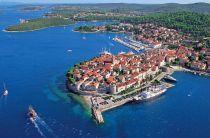
Croatia allocates €19.5M for Perna ferry terminal in Southern Dalmatia
Croatia's Ministry of the Sea, Transport, and Infrastructure has announced the construction of the Perna (Orebic) ferry terminal, with an investment...
March 12, 2025 - Cruise Industry
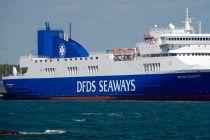
Proposed Rosyth-Dunkirk ferry service anticipated to launch in late 2025
A new direct ferry service between Scotland and France is under consideration, with operations potentially commencing in the latter half of 2025. The...
March 11, 2025 - Accidents
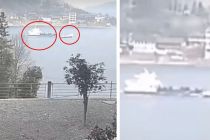
11 dead, 5 missing after ferry and oil spill vessel crash on Yuanshui River (China)
On Tuesday morning, February 25th, a collision occurred on the Yuanshui River in Hunan province (China) between a small ferry and a larger oil spill...
March 1, 2025 - Cruise Industry
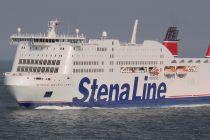
Stena Line's new ferries for the Belfast-Heysham route named Connecta and Futura
Swedish ferry company Stena Line has launched its second methanol-ready NewMax hybrid ferry at China Merchants Jingling Shipyard. Following the...
February 25, 2025 - Accidents

Severe gales disrupt ferry and flight services to Isle of Man (UK)
Severe gales have disrupted transport links to and from the Isle of Man, affecting both passenger ferry services and flights on Sunday, February 24th...
February 24, 2025 - Cruise Industry

Gotlandsbolaget orders next-generation high-speed multi-fuel ferry from Austal
Gotlandsbolaget (the shipowner of Birka Gotland) has confirmed an order for a next-generation high-speed ferry, developed in collaboration with...
February 22, 2025 - Cruise Industry

Balearia launches first fully electric ferry route between Spain and Morocco
Spanish ferry operator Balearia will introduce the first fully electric ferry service on the Tarifa-Tangier Ville route, connecting Spain (Andalusia...
January 31, 2025 - Cruise Industry
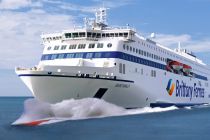
Brittany Ferries' new ship Saint-Malo conducted first LNG bunkering in Portsmouth UK
Portsmouth International Port UK has successfully conducted its first LNG bunkering operation, marking a significant step towards its goal of...
January 29, 2025 - Cruise Industry

Damen delivers Germany’s first fully-electric catamaran ferry (E-KAT) to Reederei Norden-Frisia
The Dutch shipbuilder Damen Shipyards Group delivered Germany’s first fully electric catamaran ferry (E-Kat) to the shipowner - the German...
January 28, 2025 - Accidents
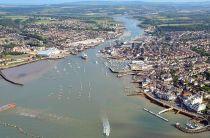
Ferry services between Isle of Wight and Southampton UK suspended due to Storm Herminia
Ferry shipping between the Isle of Wight and Southampton England are suspended indefinitely as Storm Herminia impacts the region. The company Red...
January 26, 2025 - show more news

